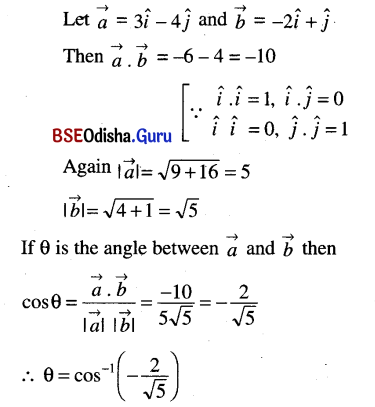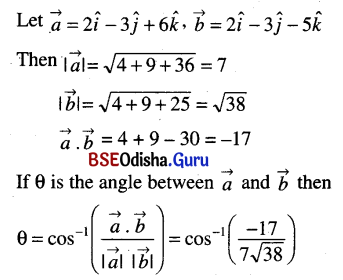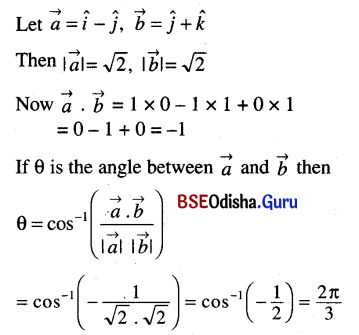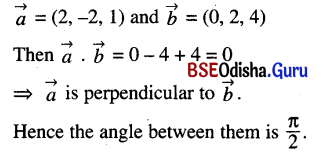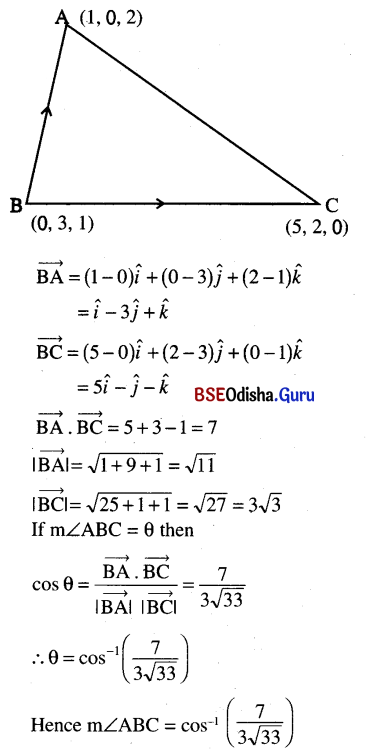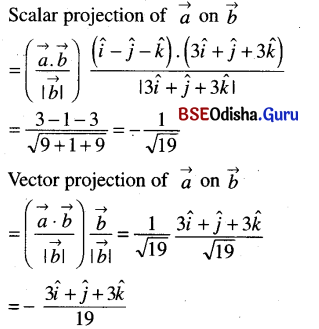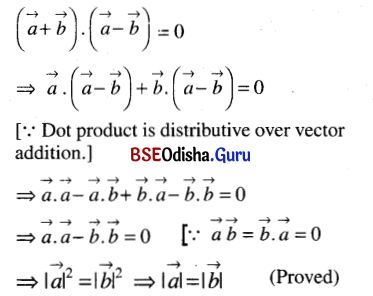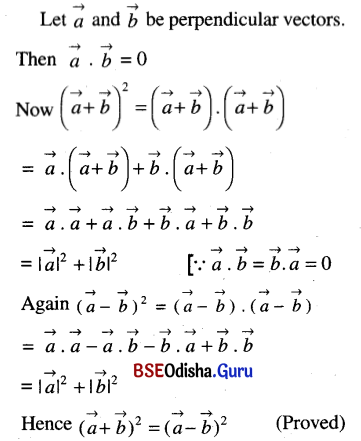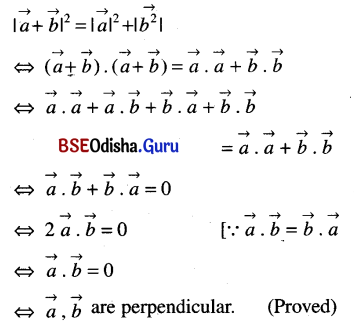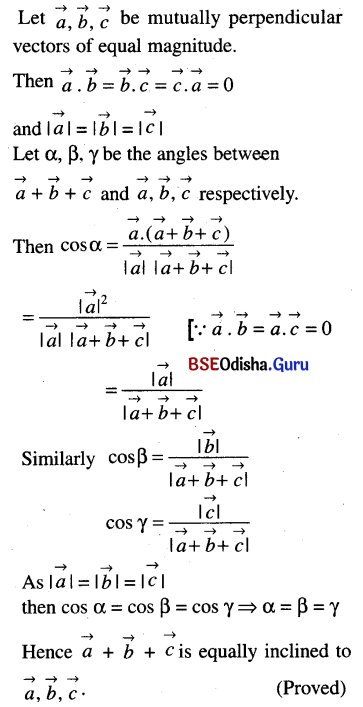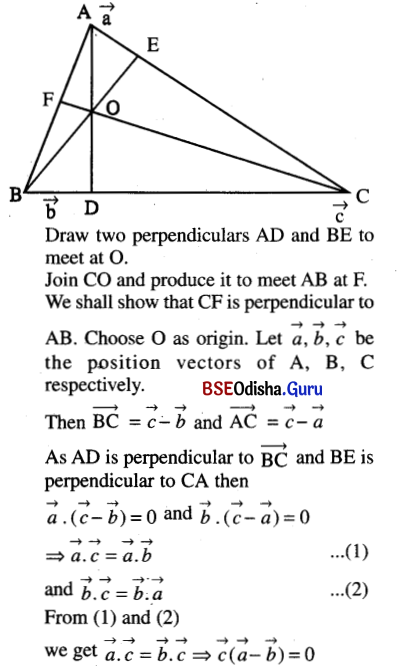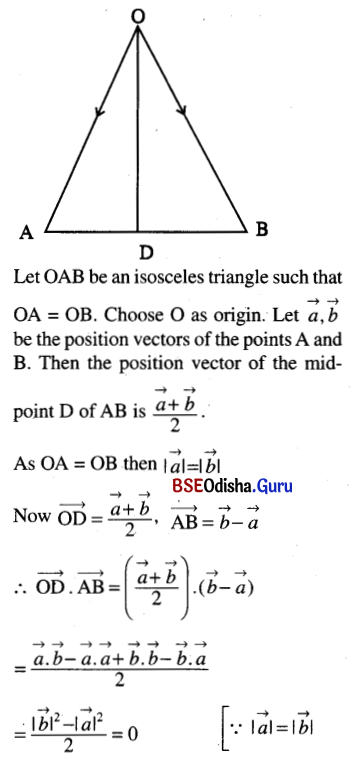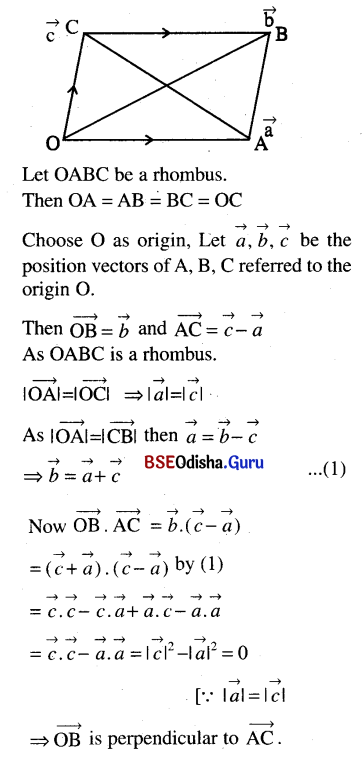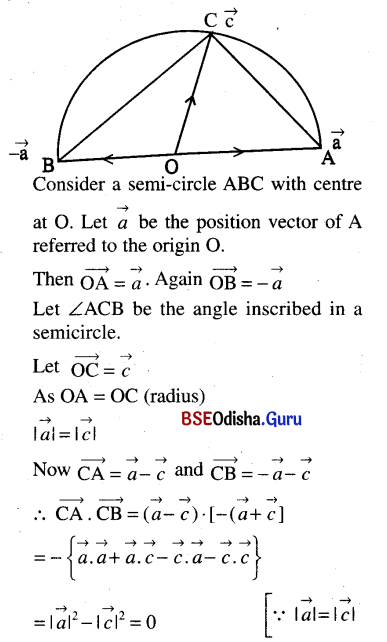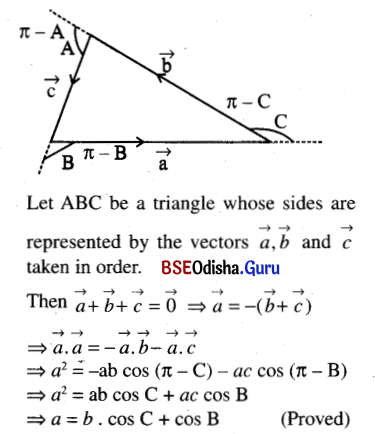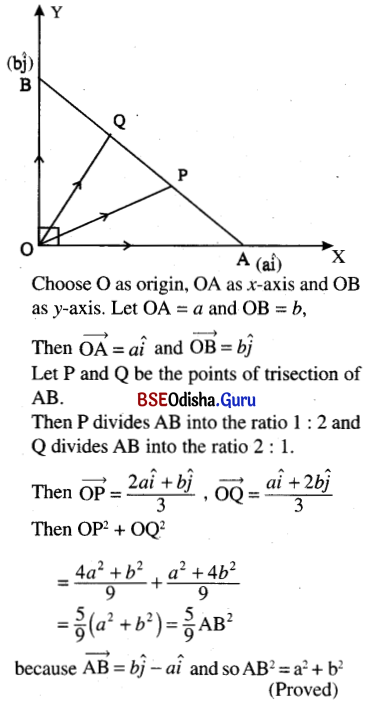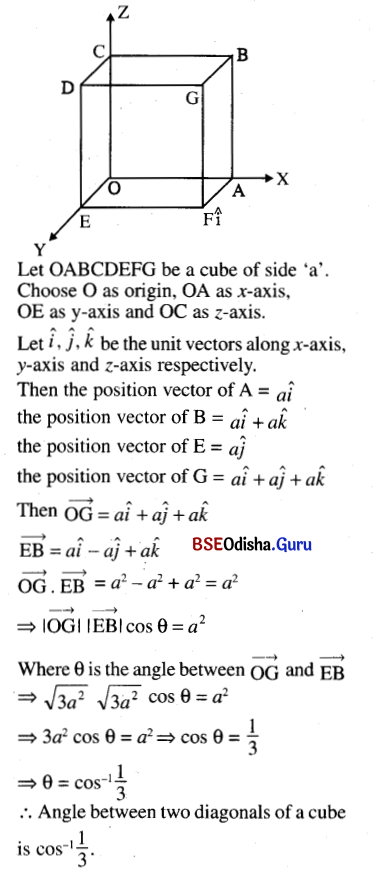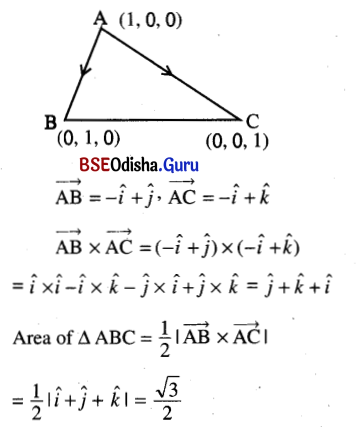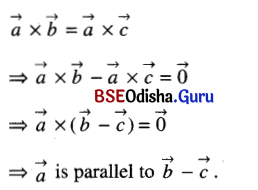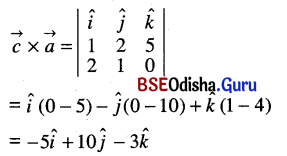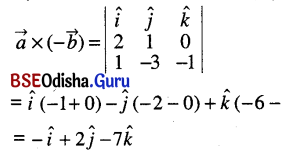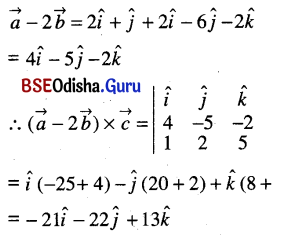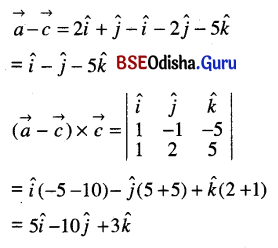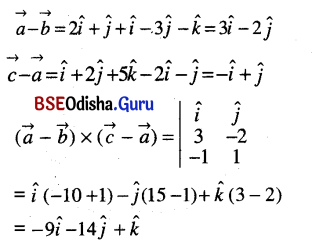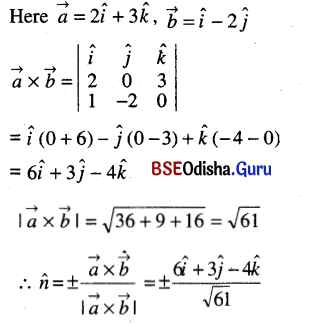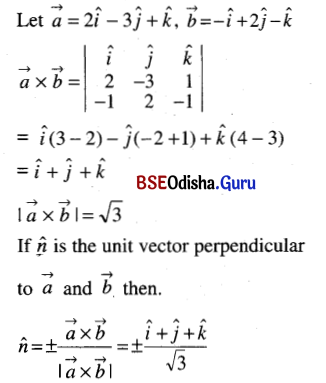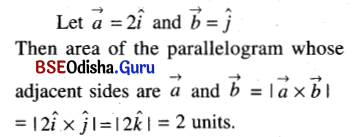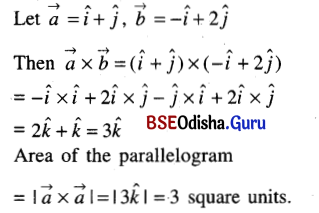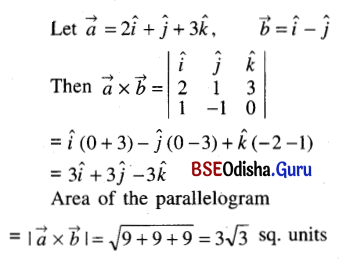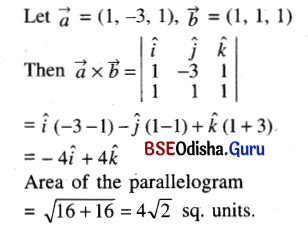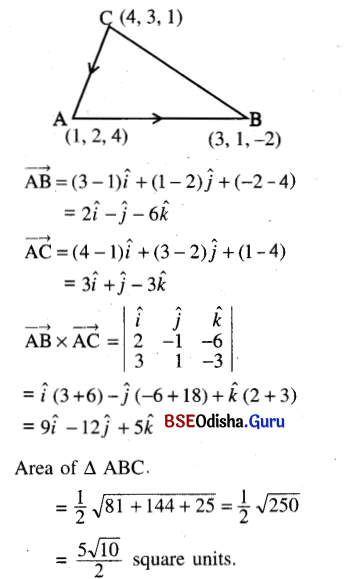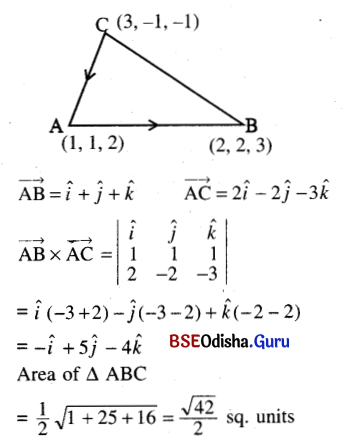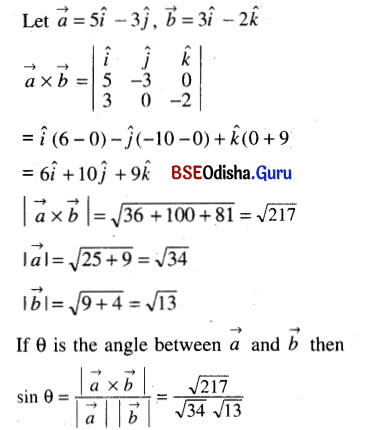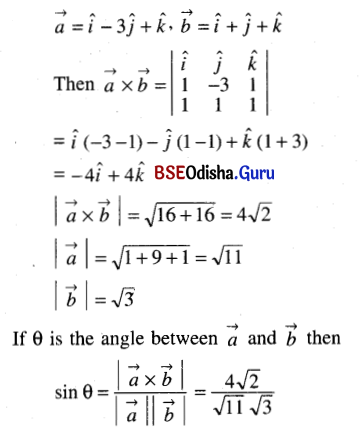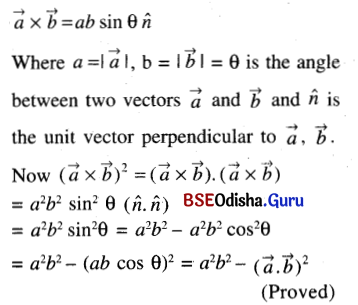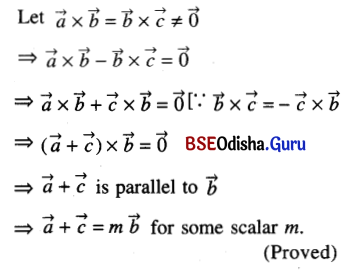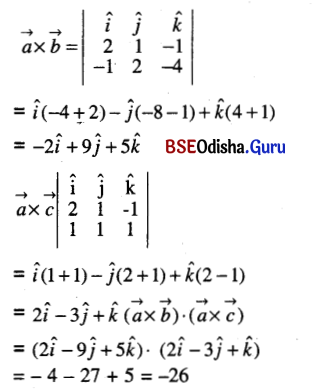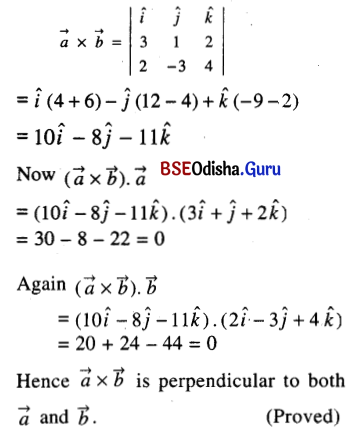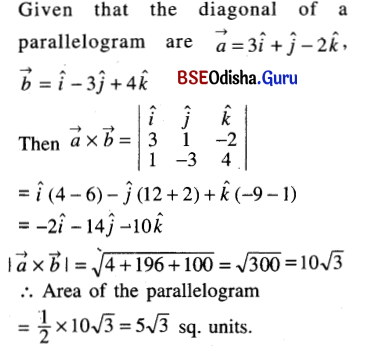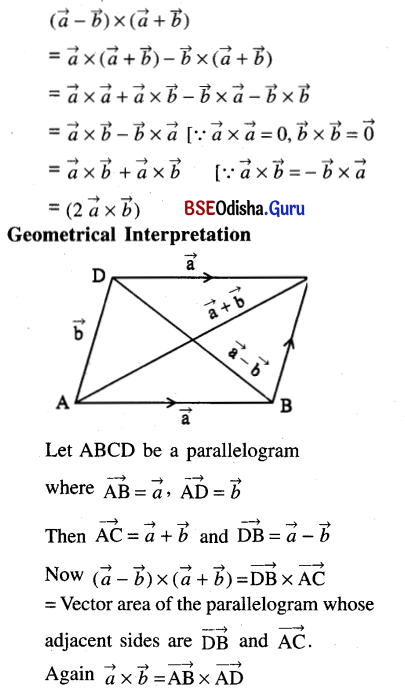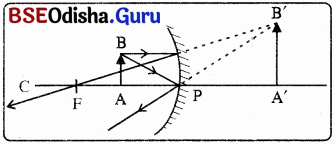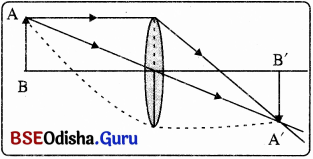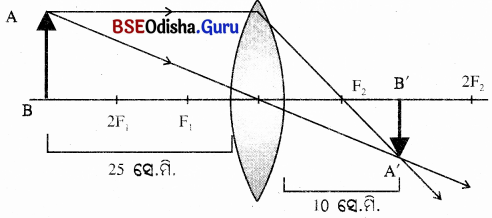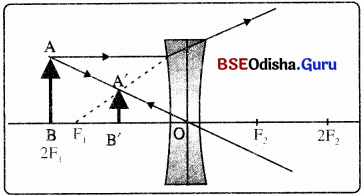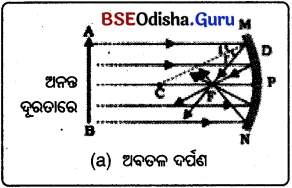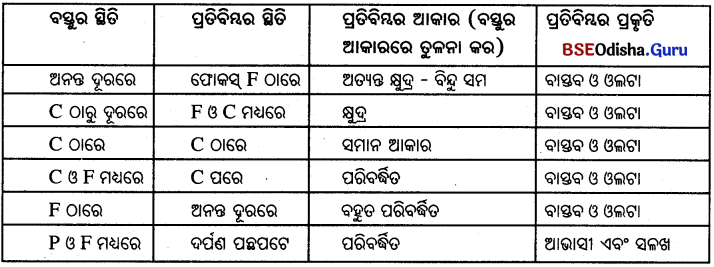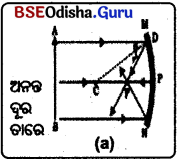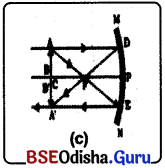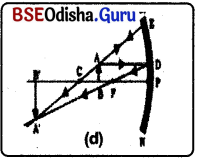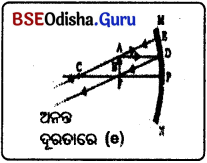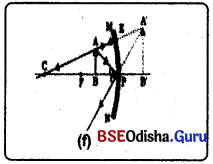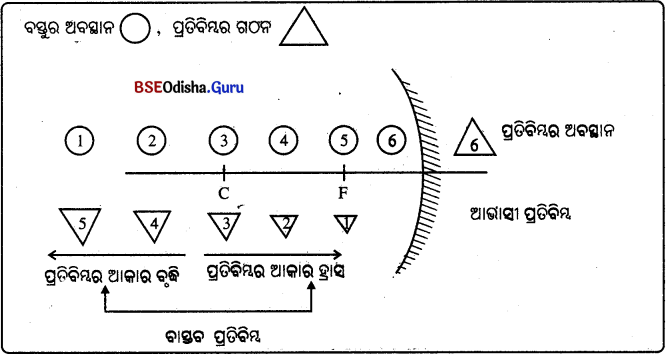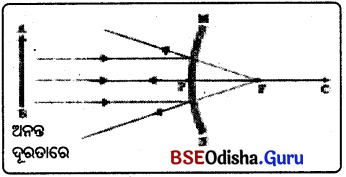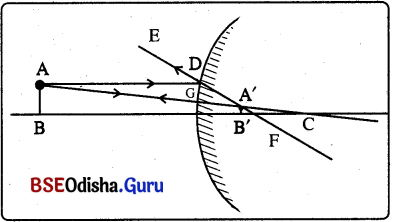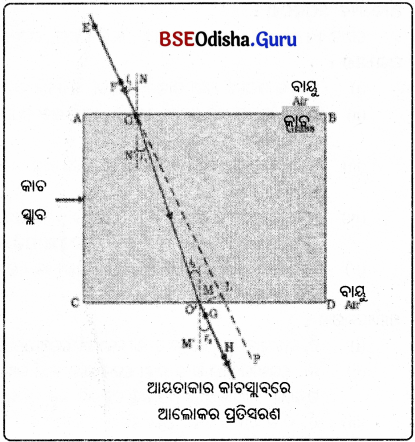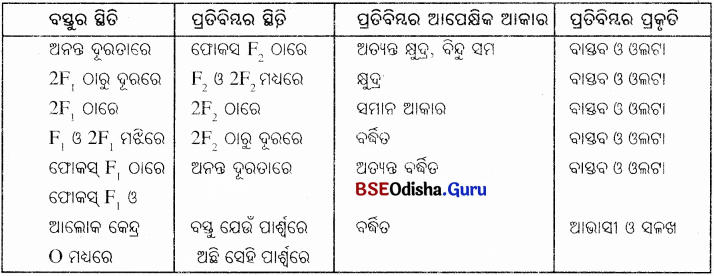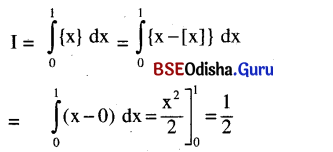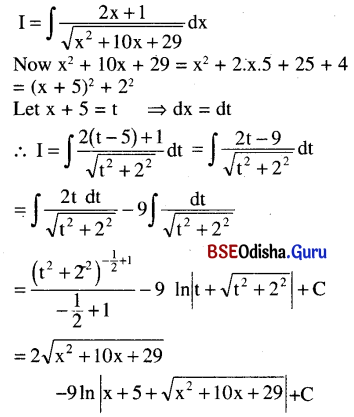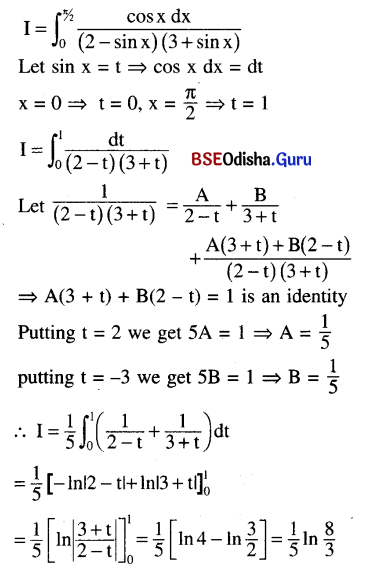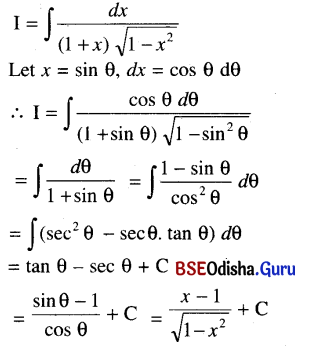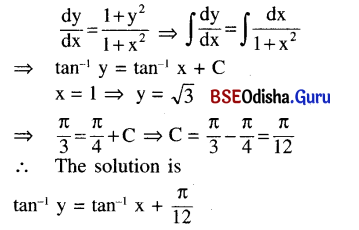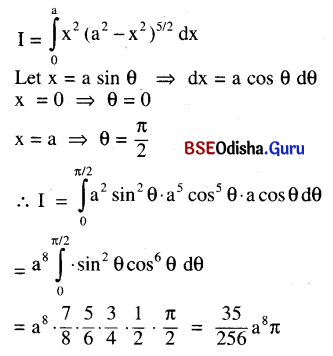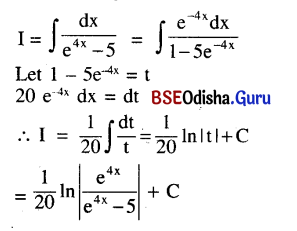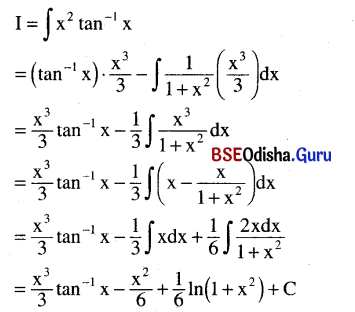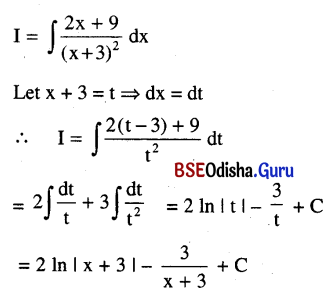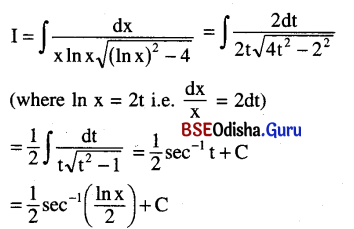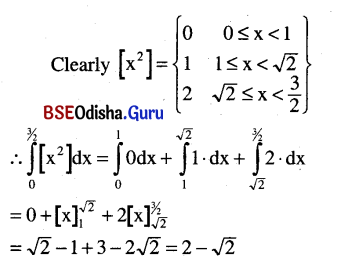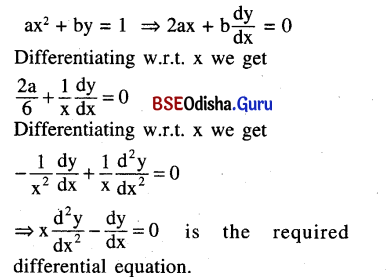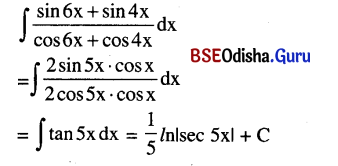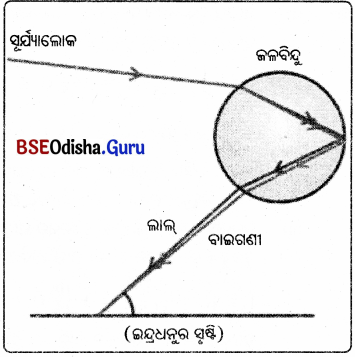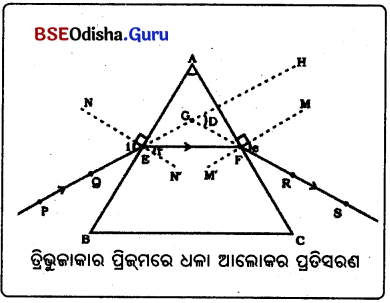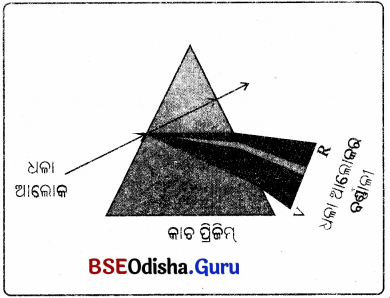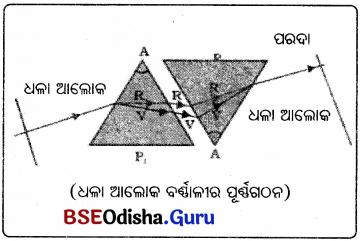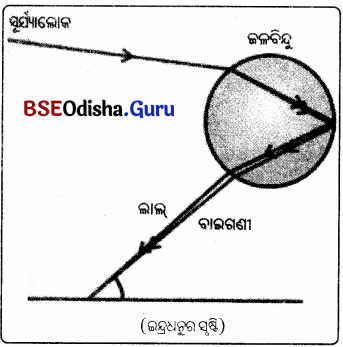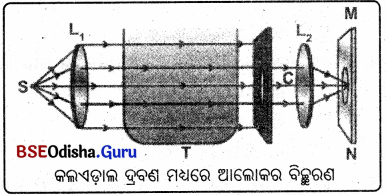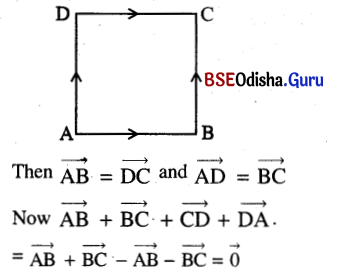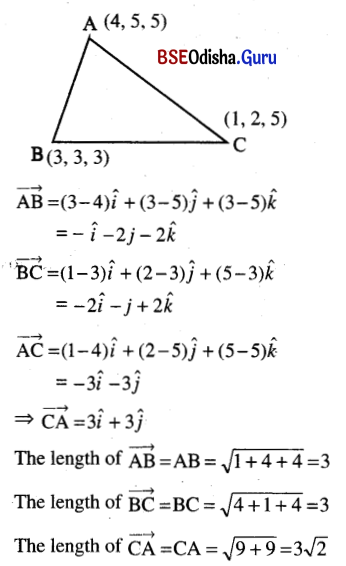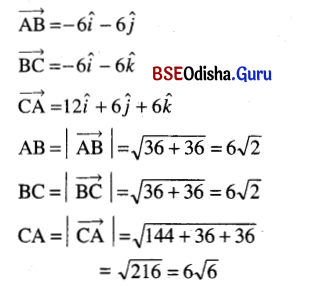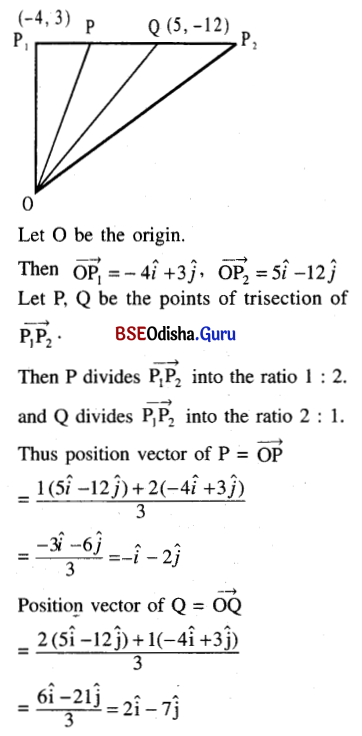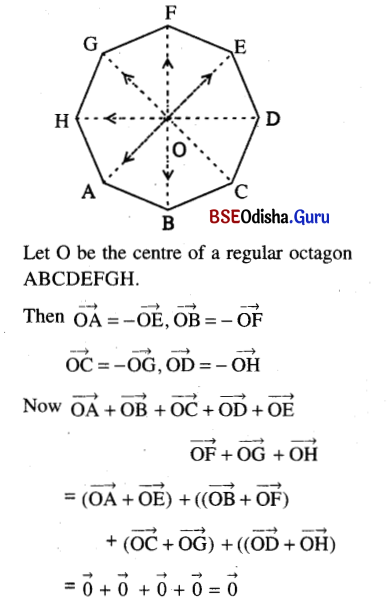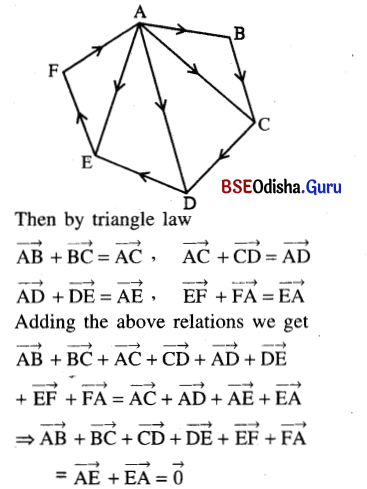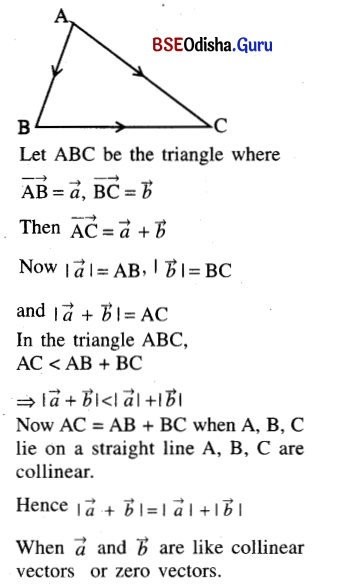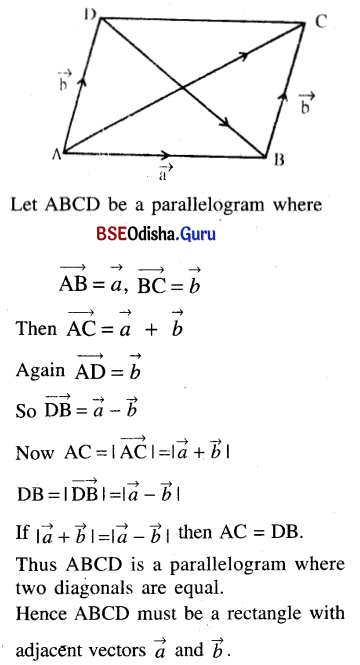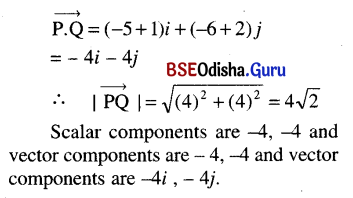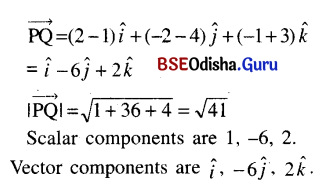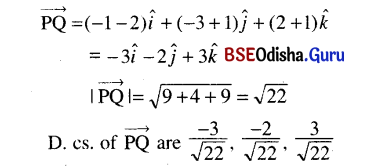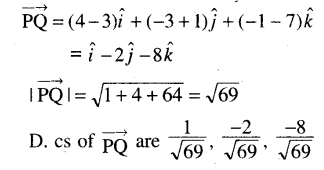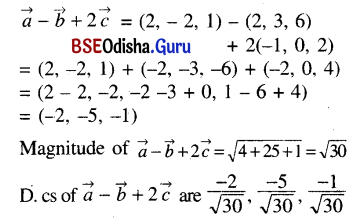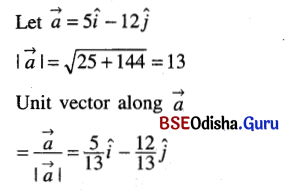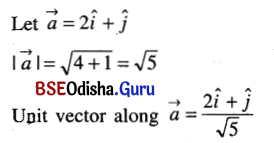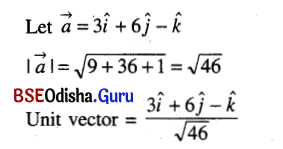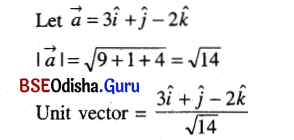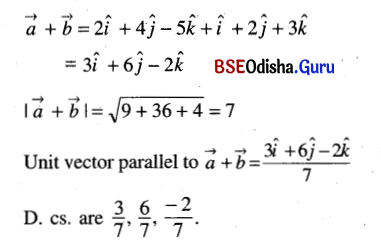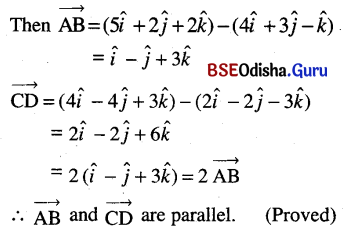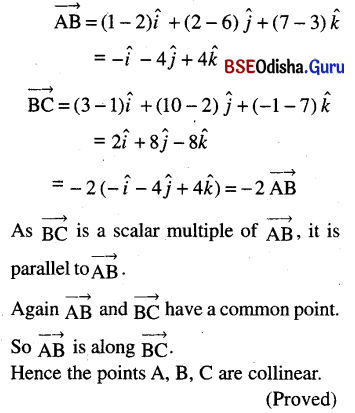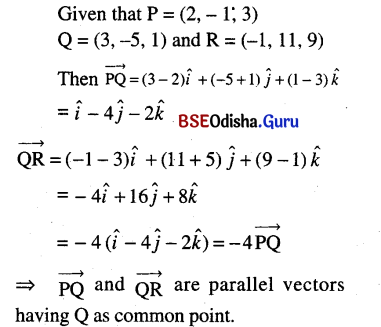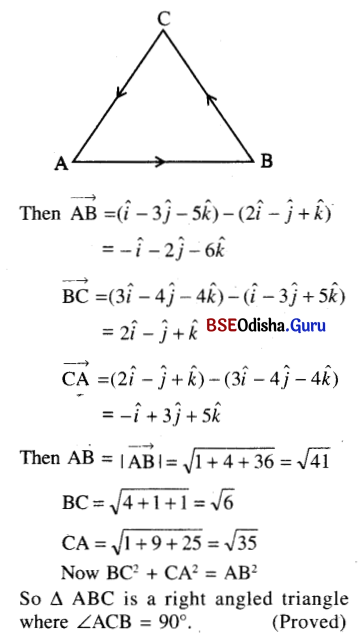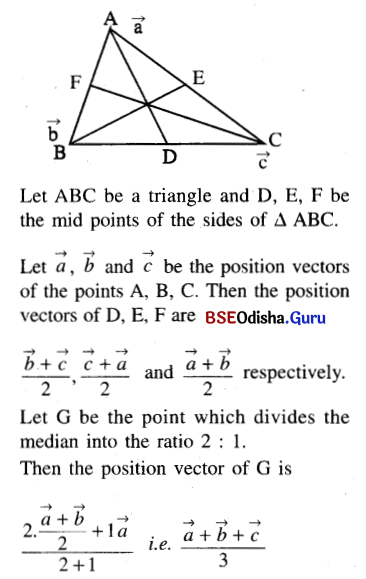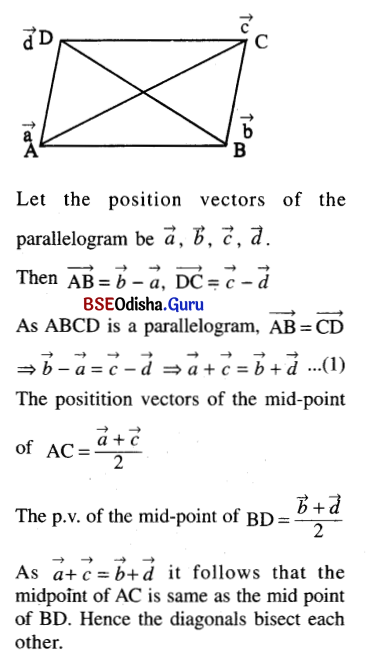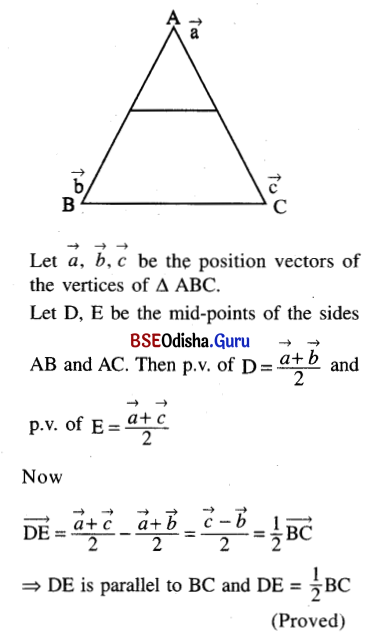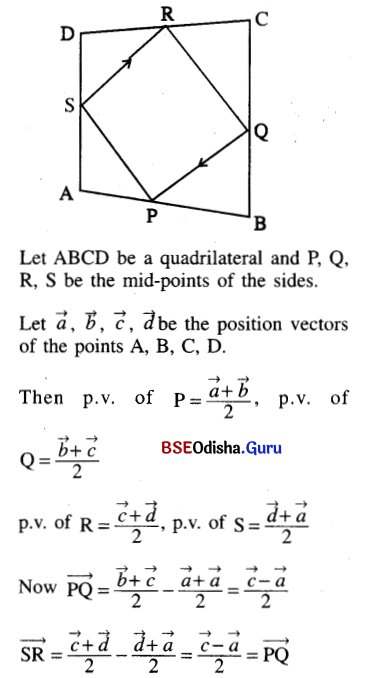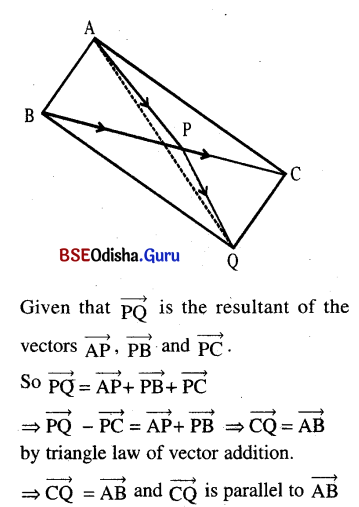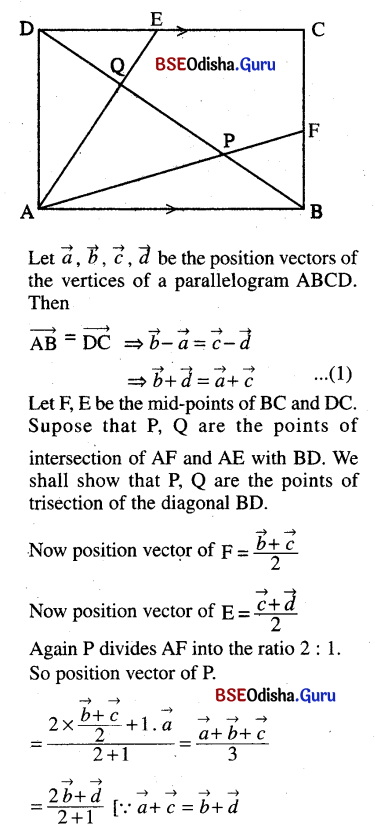Odisha State Board BSE Odisha 9th Class Hindi Solutions Chapter 1 श्रम की प्रतिष्ठा Textbook Exercise Questions and Answers.
BSE Odisha Class 9 Hindi Solutions Chapter 1 श्रम की प्रतिष्ठा
प्रश्न और अभ्यास (ପ୍ରଶ୍ନ ଔର୍ ଅଭ୍ୟାସ)
1. निम्नलिखित प्रश्नों के उत्तर दो-तीन वाक्यों में दीजिए।
(ନିମ୍ନଲିଖୂ ପ୍ରଶ୍ନ କେ ଉତ୍ତର ଦୋ-ତୀନ୍ ବାର୍କୋ ମେଁ ଦୀଜିଏ) ।
(ନିମ୍ନଲିଖ ପ୍ରଶ୍ନଗୁଡ଼ିକର ଉତ୍ତର, ଦୁଇ-ତିନୋଟି ବାକ୍ୟରେ ଦିଅ ।)
(क) कर्मयोगी होने पर कौन-सा फायदा मिलता है?
(କର୍ମଯୋଗୀ ହୋନେ ପର୍ କୌନ୍-ସା ଫାୟଦା ମିତାହୈ ?)
(ପରିଶ୍ରମୀ ହେଲେ କେଉଁ ଲାଭ ମିଳିପାରିବ ?)
उत्तर:
कर्मयोगी होने पर यह फायदा मिलता है कि कर्मयोगी जीवन में पाप का आसानी से प्रवेश नहीं हो सकता। दिन भर कर्म करने हेतु पाप-चिंतन को समय नहीं मिलता और रात को थका -माँदा शरीर आराम चाहता है। वे श्रम से रोजी रोटी कमाते है।
(ख) फुरसती लोगों को कर्मयोगी क्यों कहा नहीं जा सकता?
(ଫୁରସତା ଲୋଗେଁ। କୋ କର୍ମଯୋଗୀ କ୍ୟା କହା ନେହୀ ଜା ସକ୍ତା ?)
(ଅଳସୁଆ (କାମରୁ ମୁକ୍ତି) ଲୋକମାନଙ୍କୁ କାହିଁକି କର୍ମଯୋଗୀ କୁହାଯିବ ନାହିଁ ?)
उत्तर:
फुरसती लोगों के जीवन में पाप दिखता है। उसके पास समय फाजिल पड़ा है। इससे शैतान का काम शरू होता है। वे श्रम को टालता है, वे कई प्रकार के व्यसन में होते है इसलिए उसको कर्मयोगी कहा नहीं जा सकता।
(ग) देहाती लोग अपने बच्चों को तालीम देनेकी बात क्यों करते हैं?
(ଦେହ।ତା ଲୋଗୁ ଅପନେ ବର୍ଡୋ କୋ ତାଲିମ୍ ଦେନେକୀ ବାତ୍ କୈ କର୍ତେ ହୈ ? (ଗ୍ରାମିଣ ଲୋକ ନିଜର ପିଲାମାନଙ୍କୁ ପ୍ରଶିକ୍ଷଣ ଦେବାର କଥା କାହିଁକି କହିଛନ୍ତି ?)
उत्तर:
देहाती लोग अपने बच्चों को तालीम देने की बात करने का कारण यह है कि बच्चा ज्ञानी बनेगा, -धर्म-ग्रन्थ पढ़ सकेगा और जीवन में हर काम विचार पूर्वक करेगा। फिर भी लडके को नौकरी मिलेगी जिससे मजदूर बनकर दिन भर खटना न पड़ेगा।
(घ) भगवान् कृष्ण ने श्रम का आदर कैसे किया?
(ଭଗବାନ୍ କୃଷ୍ଣ ନେ ଶ୍ରମ୍ କା ଆଦର୍ କୈସ୍ କିୟା ?)
(ଭଗବାନ୍ କୃଷ୍ଣ ଶ୍ରମର ଆଦର କିପରି କଲେ ?)
उत्तर:
भगवान् कृष्ण ने श्रम का आदर इसलिए किया कि कोई भी काम छोटा या बड़ा नहीं होता है। दृष्टान्त यह है कि कृष्ण ने राजसूय यज्ञ में जूठी पत्तले उठाने का काम लिया।
(ङ) ज्ञानी और मजदूर में क्या फर्क होता है?
(ଜ୍ଞାନୀ ଔର୍ ମଜଦୂର୍ ମେଁ କ୍ୟା ଫର୍କ ହୋତା ହୈ ?)
(ଜ୍ଞାନୀ ଏବଂ ମୂଲିଆ ମଧ୍ୟରେ କ’ଣ ତଫାତ୍ ଅଛି ?)
उत्तर:
ज्ञानी और मजदूर में यह फर्क है कि ज्ञानी खा सकते हैं और आशीर्वाद दे सकते है, काम नहीं कर सकते मगर मजदूर सवेरे उठकर पीसता है। ज्ञानी को काम नहीं करना चाहिए।
(च) शारीरिक और दिमागी श्रम की प्रतिष्ठा कैसे बढ़ सकती है?
(ଶାରୀରିକ ଔର୍ ଦିମାଗା ଶ୍ରମ କୀ ପ୍ରତିଷ୍ଠା କୈସେ ବଢୁ ସକ୍ତୀ ହୈ ?)
(ଶାରୀରିକ ଓ ମସ୍ତିଷ୍କ ଶ୍ରମର ପ୍ରତିଷ୍ଠା କିପରି ବଢ଼ି ପାରିବ ?)
उत्तर:
शारीरिक श्रम करने वाले को हमें नीच मानना नहीं चाहिए। शारीरिक श्रम और दिमागी काम का मूल्य समान होना जरुरत है। शारीरिक श्रम और दिमागी काम दोनों करने वालों को हर सुविधा सुयोग ठीक से प्रदान हो तो श्रम की प्रतिष्ठा बढ़ सकती है।

2. निम्नलिखित प्रश्नों का उत्तर एक-एक वाक्य में दीजिए।
(ନିମ୍ନଲିଖୂ ପ୍ରଶ୍ନ କା ଉତ୍ତର୍ ଏକ୍-ଏକ୍ ବାକ୍ୟ ମେଁ ଦୀଜିଏ) ।
(ନିମ୍ନଲିଖ ପ୍ରଶ୍ନଗୁଡ଼ିକର ଉତ୍ତର ଗୋଟିଏ-ଦୁଇଟି ବାକ୍ୟରେ ଦିଅ)
(क) शेषनाग किसे कहा गया है?
(ଶେଷନାଗ୍ କିସେ କହା ଗୟା ହୈ ?)
(ଶେଷନାଗ କାହାକୁ କୁହାଯାଇଛି ?)
उत्तर:
दिनभर शरीर – श्रम करने वाले मजदूर जो किस्म-किस्म की पैदावार करते है उसे शेषनाग कहा गया है।
(ख) कौन धर्म-पुरुष हो जाता है?
(କୌନ୍ ଧର୍ମ-ପୁରୁଷ୍ ହୋ ଜାତା ହୈ ?)
(କିଏ ଧର୍ମ ପୁରୁଷ ହୋଇପାରିବ ?)
उत्तर:
जो आदमी पसीने से रोटी कमाता है, वह धर्म पुरुष हो जाता है।
(ग) किसके जीवन में पाप का आसानी से प्रवेश नहीं हो सकता?
(କିସ୍ ଜୀବନ ମେଁ ପାପ କା ଆସାନୀ ସେ ପ୍ରବେଶ ନେହୀ ହୋ ସକତା ?)
(କାହାର ଜୀବନର ପାପ ସହଜରେ ପ୍ରବେଶ କରିପାରିବ ନାହିଁ ?)
उत्तर:
धर्म-पुरुष के जीवन में पाप का आसानी से प्रवेश नहीं हो सकता।
(घ) किसे कर्मयोगी कहा जा सकता है?
(କିସେ କର୍ମୟୋଗୀ କହା ଜା ସକତା ହୈ ?)
(କାହାକୁ କର୍ମଯୋଗୀ କୁହାଯିବ ?)
उत्तर:
जो आदमी श्रम को टालता नहीं, किसी प्रकार के व्यसन उनमें नहीं होते है और लाचारी से कर्म नहीं करते, उसे कर्मयोगी कहा जा सकता है।
(ङ) फुरसती लोगों के जीवन में पाप क्यों दीखता है?
(ଫୁର୍ସତୀ ଲୋଗୋଁ କେ ଜୀବନ୍ ମେଁ ପାପ କେଁ ଦୀଖ୍ତା ହୈ ?)
(ଅଳସୁଆ ବା ଶ୍ରମବିମୁଖ ଲୋକମାନଙ୍କ ଜୀବନରେ ପାପ କାହିଁକି ଦେଖାଯାଏ ?)
उत्तर:
फुरसती लोगों के जीवन में शैतान का काम शुरू होता है, इसलिए जीवन में पाप दीखता है।
(च) मजदूरों को नीच कौन समझता है?
(ମକ ତୁରେଁ ଜୋ ନୀଚ କୌନ୍ ସମଝାତା ହୈ?)
(ଶ୍ରମିକମା ନଙ୍କୁ କେଉଁମାନେ ନୀଚ ଭାବନ୍ତି ?)
उत्तर:
दिमागी काम करने वाले लोग मजदूरों को नीच समझते है।
(छ) किसने कहा कि सीता को दीप की बाती भी जलाने नहीं आती?
(କିତ୍ସୂନେ କାହା କି ସାତା କୋ ଦୀପ୍ କୀ ବାତୀ ଭୀ ଜଲାନେ ନେହୀ ଆତୀ ?)
(କିଏ କହିଛନ୍ତି ଯେ ସୀତା କୁଜୀପର ସଳିତା ମଧ୍ୟ ଜଳିବାକୁ ଆସିବ ନାହିଁ)
उत्तर:
कौशल्या ने कहा कि सीता को दीप की बाती भी जलाने नहीं आती।
(ज) कृष्ण ने धर्मराज से क्या कहा?
କୃଷ୍ଣ ନେ ଧର୍ମରାଜ୍ ସେ କ୍ୟା କହା ?
(କୃଷ୍ଣ ଧର୍ମରାଜଙ୍କୁ କ’ଣ କହିଲେ ?)
उत्तर:
कृष्ण ने धर्मराज से कहा, “मुझे भी काम दो”।
(झ) ज्ञानी क्या नहीं कर सकते?
(ଜ୍ଞାନୀ କ୍ୟା ନେହୀ କର୍ ସଲ୍ ?)
(ପଣ୍ଡିତ କ’ଣ କରିପାରିବେ ନାହିଁ ?)
उत्तर:
ज्ञानी काम नहीं कर सकते।
(ञ) कौन मजदूर कहलाएगा?
(କୌନ୍ ମଜଦୂର୍ କହଲାଏଗା ?)
(କାହାକୁ ମୂଲିଆ (ଶ୍ରମିକ) କୁହାଯିବ ?)
उत्तर:
जो आदमी सवेरे उठकर पीसता है, वह मजदूर कहलाएगा।
(ट) किसका जीवन धार्मिक नहीं होता
(କାହାର ଜୀବନ ଧାର୍ମିକ ହୁଏ ନାହିଁ ?)
କିସ୍ ଜୀବନ୍ ଧାର୍ମିକ୍ ନେହୀ ହୋତା ?
उत्तर:
जो व्यक्ति काम टालते हैं और काम नहीं करते उसका जीवन धार्मिक नहीं होता।
(ठ) हम काम की इज्जत नहीं करते तो कौन-सा कार्य खोते हैं?
(ହମ୍ କାମ୍ କୀ ଇଜତ୍ ନେହୀ କର୍ତେ ତୋ କୌନ୍-ସା କାର୍ୟ ଖୋତେ ହେଁ ?)
(ଆମ୍ଭେ କାମର ସମ୍ମାନ କରିବା ନାହିଁତ ତେବେ କେଉଁ କାମ ନଷ୍ଟ ହେବ ?)
उत्तर:
हम काम की इज्जत नहीं करते तो धर्म-कार्य खोते हैं?
(ड) ब्राह्मण को अपरिग्रही क्यों माना गया था?
ବ୍ରାହ୍ମଣ୍ କୋ ଅପରିଗ୍ରହୀ ବ୍ୟୋ ମାନା ଗୟା ଥା ?
(ବ୍ରାହ୍ମଣକୁ ନିର୍ଲୋଭୀ କାହିଁକି କୁହାଯାଉଥିଲା ?)
उत्तर:
ब्राह्मण सिर्फ धोती और खाने का अधिकारी होने के साथ ज्ञानी होता था, इसलिए अपरिग्रही माना गया था।
(ढ) कब श्रम की प्रतिष्ठा होगी?
(କବ୍ ଶ୍ରମକୀ ପ୍ରତିଷ୍ଠା ହୋଗୀ ?)
(କେବେ ଶ୍ରମର ପ୍ରତିଷ୍ଠା ହେବ ?)
उत्तर:
शारीरिक और मानसिक कामों का मूल्य समान होने से श्रम की प्रतिष्ठा होगी।

3. निम्नलिखित प्रश्नों का उत्तर एक-एक शब्द में दीजिए।
ନିମ୍ନଲିଖୂ ପ୍ରଶ୍ନ କେ ଉତ୍ତର୍ ଏକ୍-ଏକ୍ ଶବ୍ଦ ମେଁ ଦୀଜିଏ ।
(ନିମ୍ନଲିଖ ପ୍ରଶ୍ନଗୁଡ଼ିକର ଉତ୍ତର ଗୋଟିଏ-ଗୋଟିଏ ଶବ୍ଦରେ ଦିଅ ।)
(क) यह पृथ्वी किसके मस्तक पर स्थित है?
(ୟହ ପୃଥିବୀ କିସ୍ ମସ୍ତକପର୍ ସ୍ଥିତ ହୈ?)
(ଏହି ପୃଥିବୀ କାହାର ମସ୍ତକ ଉପରେ ଅବସ୍ଥିତ ?)
उत्तर:
शेषनाग
(ख) भगवान् ने किसे कर्मयोगी कहा है?
(ଭଗବାନ୍ ନେ କିସେ କର୍ମୟୋଗୀ କହା ହୈ ?)
(ଭଗବାନ କାହାକୁ କର୍ମଯୋଗୀ କହିଛନ୍ତି ?)
उत्तर:
मजदूरों को
(ग) अपने पसीने से कौन रोटी कमाता है?
(ଅପ୍ ପସୀନେ ସେ କୌନ୍ ରୋଟୀ କମାତା ହୈ ?)
(ନିଜ ପରିଶ୍ରମରେ କିଏ ରୋଜଗାର କରନ୍ତି? )
उत्तर:
मजदूर
(घ) किसे कर्मयोगी कहा नहीं जा सकता?
(କିସ୍ କର୍ମୟୋଗୀ କହା ନେତ୍ରୀ ଜା ସକ୍ତା ?)
(କାହାକୁ କର୍ମଯୋଗୀ କୁହାଯିବ ନାହିଁ ?)
उत्तर:
श्रम टालने वाले को
(ङ) जहां समय फाजिल पड़ा होता है, वहां किसका काम शुरू हो जाता है?
(ଜହାଁ ସମୟ ଫାଜିଲ୍ ପଡ଼ା ହୋତା ହୈ, ୱହାଁ କିସ୍ କା କାମ ଶୁରୁ ହୋ ଜାତା ହୈ ?)
(ଯେଉଁଠାରେ ସମୟ ଆବଶ୍ୟକଠାରୁ ଅଧିକ ହେବ, ସେଠାରେ କାହାର କାମ ଆରମ୍ଭ ହେଉଛି ?)
उत्तर:
शैतान का
(च) किन-किन लोगों के जीवन में पाप दिखता है?
(କିନ୍-କିନ୍ ଲୋଗୋଁ କେ ଜୀବନ୍ ମେଁ ପାପ ଦିଖ୍ ହୈ ?)
(କେଉଁ ଲୋକମାନଙ୍କ ଜୀବନରେ ପାପ ଦେଖାଯାଏ ?)
उत्तर:
फुरसती, मजदूर
(छ) कौन कहता है कि उनके बच्चों को तालीम मिलनी चाहिए?
(କୌନ୍ କହତା ହୈ କି ଉକେ ବର୍ଡୋ କୋ ତାଲିମ୍ ମିଲନୀ ଚାହିଏ ?)
(କିଏ କହନ୍ତି ଯେ ତାଙ୍କର ପିଲାମାନଙ୍କୁ ପ୍ରଶିକ୍ଷଣ ମିଳିବା ଉଚ୍ଚିତ୍ ?)
उत्तर:
देहातीलोग
(ज) राजसूय यज्ञ किसने किया था?
(ରାଜସୂୟ ୟଜ୍ଞ କିସ୍ କିୟା ଥା ?)
(ରାଜସ୍ଵୟ ଯଜ୍ଞ କିଏ କରିଥିଲେ ?)
उत्तर:
धर्मराज
(झ) कौन-से श्रम की प्रतिष्ठा मानी गयी है?
କୌନ୍ ସେ ଶ୍ରମ କୀ ପ୍ରତିଷ୍ଠା ମାନୀ ଗୟୀ ହୈ ? (କେଉଁ ଶ୍ରମର ପ୍ରତିଷ୍ଠା ସ୍ଵୀକାର କରାଯାଇଛି ? ବା କେଉଁ ଶ୍ରମକୁ ପ୍ରତିଷ୍ଠିତ ଶ୍ରମ ବୋଲି ସ୍ଵୀକାର କରାଯାଇଛି ?)
उत्तर:
दिमागी काम
(अ) दिमागी काम कौन करता था?
(ଦିମାଗୀ କାମ୍ କୌନ୍ କରିତା ଥା ?)
(ମାନସିକ ଶ୍ରମ ବା ମସ୍ତିଷ୍କ ଶ୍ରମ କିଏ କରିଥିଲେ ?)
उत्तर:
महात्मा गाँधी
(ट) अपरिग्रही किसे माना गया था?
(‘ଅପରିଗ୍ରହୀ କିସ୍ ମାନ ଗୟା ଥା ?)
(‘ନିର୍ଲୋଭୀ’ କାହାକୁ କୁହାଯାଉଥିଲା ?)
उत्तर:
ब्राह्मण
(ठ) बिना काम किये हमारा जीवन कैसा बनता है?
(ବିନା କାମ୍ କିୟେ ହମାରା ଜୀବନ୍ କୈସେ ବନ୍ହୈ ?)
(କାମ ବିନା ଆମର ଜୀବନ କିପରି ହେବ ?)
उत्तर:
पापी
(ड) किसका मूल्य समान होना चाहिए?
(କିସ୍ ମୂଲ୍ୟ ସମାନ୍ ହୋନା ଚାହିଏ ?)
(କାହାର ମୂଲ୍ୟ ସମାନ ହେବା ଉଚିତ ?)
उत्तर:
काम का

4. निम्नलिखित अवतरणों का आशय स्पष्ट कीजिए।
(ନିମ୍ନଲିଖ୍ ଗଦ୍ୟଖଣ୍ଡ ଗୁଡ଼ିକର ଉଦ୍ଦେଶ୍ୟ ସ୍ପଷ୍ଟ କର ।)
(क) लेकिन सिर्फ कर्म करने से कोई कर्मयोगी नहीं होता।
उत्तर:
ଲେକିନ୍ ସିଫ୍ କର୍ମ କର୍ନେ ସେ କୋଈ କର୍ମୟୋଗୀ ନେହୀ ହୋତା ।
(କିନ୍ତୁ କେବଳ କର୍ମ କରିବା ଦ୍ୱାରା କେହି କର୍ମଯୋଗୀ ହୁଏ ନାହିଁ ।)
उत्तर:
यह अबतरण ‘श्रम की प्रतिष्ठा’ से लिया गया है। यहाँ बिनोबा जी कर्मयोगी पर वर्णन किया है। संसार में हर आदमी कर्म करते है लेकिन सभी कर्म का मूल लक्ष्य निर्द्दिष्ट होना चाहिए । मजदूर दिन रात कर्म करते है, वह कर्मयोगी नहीं कहलाता। कर्म करने के साथ भगवान पर ध्यान रखना है। जो व्यक्ति अपने पसीने से रोटी कमाते है वह कर्मयोगी कहलाते है।
(ख) जहाँ समय फाजिल पड़ा है, वहाँ शैतान का काम शुरू हो जाता है।
(ଜହାଁ ସମୟ ଫାଜିଲ୍ ପଢ଼ା ହୈ, ୱର୍ଡା ଶୈତାନ୍ କା କାମ୍ ଶୁରୁ ହୋ ଜାତା ହୈ )।
(ଯେଉଁଠାରେ ସମୟ ଆବଶ୍ୟକତା ଠାରୁ ଅଧିକ ଅଛି, ସେଠାରେ ଦୃଷ୍ଟର ବା ଶଇତାନର କାମ ଆରମ୍ଭ ହେଉଚ୍ଛା)
उत्तर:
यह गद्यखण्ड ‘श्रम की प्रतिष्ठा’ से लिया गया है। इस पर विनोबाजी ने समय के व्यवहार पर चर्चा की। जो व्यक्ति के पास समय आवश्यकता से अधिक है, वे समय को ठिक रूप से सद्व्यवहार नहीं कर सकता है। उसके जीवन मे पाप दिखता है। कर्म को पूजा नहीं समझते। वे हमेशा कुचिन्ता में फस जाता है।
(ग) ज्ञानी तो खा सकते हैं और आशीर्वाद दे सकते हैं; काम नहीं कर सकते।
ଜ୍ଞାନୀ ତୋ ଖା ସତ୍ତ୍ଵେ ହେଁ ଔର୍ ଆଶୀର୍ବାଦ୍ ଦେ ସକ୍ ହେଁ, କାମ୍ ନେହୀ କର୍ସଲ୍ । ଜ୍ଞାନୀ ଖାଇ ପାରିବ ଏବଂ ଆଶୀର୍ବାଦ ଦେଇପାରିବ, କାମ କରି ପାରିବ ନାହିଁ ।)
उत्तर:
यह अवतरण ‘श्रम की प्रतिष्ठा’ से लिया गया है। यहाँ विनोबाजी ने ज्ञानी के काम पर गुरुत्व दिया है। ज्ञानी खाता और आशीर्वाद देता इसलिए कि उसके पास ज्ञान और विबेक दोनों हैं । कोई सवेरे उठकर पीसता है वे ज्ञानी नहीं, मजदूर कहलायेगा। बूढ़ों और बच्चों को काम देना निष्ठुरता है। इसलिए बूढ़ो को काम से मुक्त रहना ठीक है।
(घ) अगर हम बिना काम किये खाते हैं तो हमारा जीवन पापी बनता है।
(ଅଗର୍ ହମ୍ ବିନା କାମ୍ କିୟେ ଖାତେ ହୈ ତୋ ହମାରା ଜୀବନ୍ ପାପୀ ବନ୍ଧା ହୈ ।)
(ଯଦି ଆମ୍ଭେ କାମ ନକରି ଖାଇବା ତ ଆମ୍ଭ ଜୀବନ ପାପୀ ବା ପାପପୂର୍ଣ୍ଣ ହୋଇଯିବ ।)
उत्तर:
यह अवतरण विनोबाजी द्वारा लिखित ‘श्रम कि प्रतिष्ठा’ से लिया गया है। प्रत्येक व्यक्ति को कुछ-न-कुछ श्रम करने के साथ समाज के सभी वर्ग के लोगों श्रम करने के सक्षम होने की कोशिश करना आवश्यक है। जो आदमी कुछ नकर खाते है, वह पापी बनाता है। शारीरिक श्रम और दिमागी काम का मूल्य भी समान होना चाहिए।
(ङ) प्रस्तुत निबंध से हमें कौन-सी शिक्षा मिलती है?
(ପ୍ରସ୍ତୁତ୍ ନିବଂଧୂ ସେ ହମ୍ କୌନ୍-ସି ଶିକ୍ଷା ମିଲ୍ ହୈ ?)
(ପ୍ରସ୍ତୁତ ନିବଂଧରୁ ଆମକୁ କେଉଁ ଶିକ୍ଷା ମିଳୁଛି ?)
उत्तर:
प्रस्तुत निबंध से यह शिक्षा मिलती है कि प्रत्येक व्यक्ति को कुछ-न-कुछ श्रम करना चाहिए। निबन्धकार के विचार है कि जो अपने पसीने से रोटी कमाता है, वह पाप कर्मों से कोसो भागता है। शारीरिक श्रम और दिमागी काम का मूल्य समान होना जरूरी है।

5. रिक्त स्थानों को भरिए। (ପ୍ରସ୍ତୁତ୍ ନିବଂଧୂ ସେ ହମ୍ କୌନ୍-ସି ଶିକ୍ଷା)
(क) इसलिए भगवान् ने ………………… कर्मयोगी कहा है।
उत्तर:
मजदूरो,
(ख) ऐसा इसलिए होता है कि वे कर्म को ………………… नहीं समझते।
उत्तर:
पूजा,
(ग) भगवान् ने कहा, आदरणीय हैं तो क्या ……………….. हैं?
उत्तर:
नालायक,
(घ) दिमागी काम करनेवालों को भी ……………. दिये हैं।
उत्तर:
हाथ,
(ङ) ……………………. जो ज्ञानी होता था, पढ़ाता था।
उत्तर:
ब्राह्मण
भाषा-ज्ञान (ଭାଷା-ଜ୍ଞାନ)
1. ‘देहाती’ शब्द देहात के साथ ‘ई’ प्रत्यय के योग से बना है। शब्द के अंत में आनेवाले, शब्दांशों को प्रत्यय कहते हैं। यहाँ ‘ई’ एक तद्धित प्रत्यय है। हिन्दी में दो प्रत्यय होते हैं – कृदन्त और तद्धित।
(ଦେହାତ ଶବ୍ଦ ସହିତ ‘ଈ’ ପ୍ରତ୍ୟୟ ଯୋଗରେ ‘ଦେହତୀ’ ହୋଇଛି । ଶବ୍ଦର ଶେଷରେ ଆସୁଥିବା ଶତାଂଶକୁ ପ୍ରତ୍ୟୟ କୁହାଯାଏ । ଏଠାରେ ‘ଈ’ ଗୋଟିଏ ତଦ୍ଧିତ ପ୍ରତ୍ୟୟ ଅଟେ ।)ହିନ୍ଦୀରେ ପ୍ରତ୍ୟୟ ଦୁଇ ପ୍ରକାର ।
(i) କୃଦନ୍ତ୍ର
(ii) ତଦ୍ଧିତ
उपर्युक्त उदाहरण की तरह ‘ई’ प्रत्यय के योग से बननेवाले शब्दों को प्रस्तुत निबंध से खोजकर लिखिए
(ଉପର ବର୍ଣ୍ଣିତ ଉଦାହରଣ ଭଳି ‘ଈ’ ପ୍ରତ୍ୟୟ ଯୋଗ ହୋଇଥିବା ଶବ୍ଦଗୁଡ଼ିକୁ ପ୍ରସ୍ତୁତ ନିବନ୍ଧରୁ ବାଛି ଲେଖ ।)
उत्तर:
कर्मयोगी, आसानी, मजदूरी, नौकरी, ज्ञानी, बेकारी, ब्यापारी, लाचारी, पापी, अधिकारी, उपकारी। ‘यह पृथ्वी शेषनाग के मस्तक पर स्थित है’।
2. ‘यह पृथ्वी शेषनाग के मस्तक पर स्थित है’।
इस वाक्य में प्रयुक्त ‘पर’ अधिकरण कारक की सप्तमी विभक्ति का चिह्न है। इसे परसर्ग भी कहते हैं।
(ଏହି ବାକ୍ୟରେ ବ୍ୟବହୃତ ‘पर’ ଅଧିକରଣ କାରକ ସପ୍ତମୀ ବିଭକ୍ତିର ଚିହ୍ନ ଅଟେ । ଏହାକୁ ମଧ୍ୟ ପରସର୍ଗ କହନ୍ତି ।)
प्रस्तुत निबंध में जहाँ-जहाँ इसी परसर्ग ‘पर’ का प्रयोग हुआ है, उन्हें छाँटकर लिखिए ।
(ପ୍ରସ୍ତୁତ ନିବନ୍ଧରେ ଯେଉଁଠାରେ ଏହି ‘पर’ ପରସର୍ଗର ପ୍ରୟୋଗ ହୋଇଅଛି, ସେଗୁଡ଼ିକୁ ବାଛି ଲେଖ ।)
उत्तर:
- यह पृथ्वी शेषनाग के मस्तक पर स्थित है।
- हिन्दुस्तान में कुछ मजदूर खेतों पर काम करते हैं।
- वह मजदूरी तो करता है पर उसमें उसे गौरब नहीं लगता।
- बेटी समान माना पर मेहनत को हीन माना गया।
- शरीर-श्रम की प्रतिष्ठा न मानों, पर महात्मा गांधी तो दिमागी काम करते थे।
(ଯଦି ଆଉ କୌଣସି ଏହି ପରି ବାକ୍ୟ ଥାଏ, ସେଗୁଡ଼ିକୁ ବାଛି ଲେଖ ।)
3. निम्नलिखित वाक्यों पर ध्यान दीजिए।
- जो शख्स पसीने से रोटी कमाता है, वह धर्म-पुरुष हो जाता है।
- अगर हम काम की इज्जत नहीं करते तो बड़ा भारी धर्म – कार्य खोते हैं।
- शरीर – श्रम करनेवाले को हम नीच मानते हैं।
इन वाक्यों में प्रयुक्त धर्म-पुरुष, धर्म – कार्य और शरीर-श्रम अधिक शब्दों के मेल से बने हैं।
(ଏହି ବାକ୍ୟଗୁଡ଼ିକରେ ବ୍ୟବହୃତ ‘ଧର୍ମ-ପୁରୁଷ’, ‘ଧର୍ମ-କାର୍ଯ୍ୟ’ ଓ ‘ଶରୀର-ଶ୍ରମ’ ଅଧିକ ଶବ୍ଦଗୁଡ଼ିକର ମିଳନରେ ଗଠିତ ହେ।ଇଚ୍ଛି)
- जैसे- धर्म (का) पुरुष
- धर्म (का) कार्य
- शरीर (का) श्रम
जब एकाधिक शब्द एक-दूसरे से मिल जाते हैं, तब उस मेल को समास कहा जाता है।
(ଯେତେବେଳେ ଏକାଧିକ ଶବ୍ଦ ଗୋଟିଏ ଅନ୍ୟଟି ସହିତ ମିଳିଯାଆନ୍ତି, ସେତେବେଳେ ସେହି ମିଳନକୁ ସମାସ କୁହାଯାଏ ।)
समास सात प्रकार के होते हैं-
- अव्ययीभाव
- तत्पुरुष समास
- नञ् तत्पुरुष
- कर्मधारय
- द्विगु
- द्वन्द्व
- बहुब्रीहि समास
उपर्युक्त उदाहरण तत्पुरुष समास के हैं।

4. ‘आज देहाती लोग भी कहते हैं कि हमारे बच्चों को तालीम मिलनी चाहिए।’ इस वाक्य में ‘आज देहाती लोग भी कहते हैं’ प्रधान वाक्य है और ‘हमारे बच्चों को तालीम मिलनी चाहिए’ आश्रित वाक्य है। इन दोनों वाक्यों को संयोजक अविकारी शब्द ‘कि’ मिलाता है।
याद रखिए:
जिस वाक्य में एक प्रधान वाक्य और एक आश्रित वाक्य हो, उसे मिश्र वाक्य कहते हैं। रचना की दृष्टि से वाक्य के अनेक भेद पाये जाते हैं – सरल वाक्य, मिश्र वाक्य, संयुक्त वाक्य आदि।
सरल वाक्य: नृत्यांगना चन्द्रिका ने नृत्य महोत्सव में सभी दर्शकों का मन मोहित कर लिया।
मिश्र वाक्य : बाण से घायल एक हंस जब उपवन में गिर पड़ा, तब राजकुमार सिद्धार्थ ने उसे तुरन्त उठा लिया।
संयुक्त वाक्य: पानी में भीगे हुए बच्चे पेड़ पर चढ़ गये और पके पके फल तोड़ने लगे।
5. इस पाठ में जीवन, लोग, काम के आगे क्रमशः धार्मिक, देहाती और दिमागी शब्दों का प्रयोग हुआ है। इन शब्दों से उनकी विशेषता उभर कर आती है। पाठ से कुछ ऐसे ही शब्द छाँटिए जो किसी की विशेषता बता रहे हों।
उत्तर:
ज्ञानी लोग
जूठी पत्तल
सफाई कर्मचारी
थका-माँदा शरीर
(ଏହିପରି ପିଲାମାନେ ଅନ୍ୟ ଶବ୍ଦକୁ ବାଛି ଲେଖୁବେ ।)
अतिरिक्त प्रश्नोत्तर
1. मजदूरों को कौन नीच समझते है?
(ମଜଦୂରୌ କୋ କୌନ୍ ନୀବ୍ ସମଝତେ ହୈ ?)
(ଶ୍ରମିକମାନଙ୍କୁ କିଏ ନୀଚ ଭାବନ୍ତି ?)
उत्तर:
दिमागी काम करने वाले लोग मजदूरों को नीच समझते है। थोड़ा-सा काम लेने के लिए जीतनी मजदूरी देनी पड़ेगी उतनी ही देंगे पर ज्यादा से ज्यादा काम लेंगे। उन्हें काम से भी घृणा ह ।
2. किसके जीवन में पाप आसानी से प्रवेश नहीं हो सकता?
(କିସ୍ ଜୀୱନ୍ ମେଁ ପାପ୍ ଆସାନୀ ସେ ପ୍ରବେଶ ନର୍ଜୀ ହୋ ସକତା) ?
(କାହା ଜୀବନରେ ପାପ ସହଜରେ ପ୍ରବେଶ କରେ ନାହିଁ ।?)
उत्तर:
हिन्दुस्तान में कुछ मजदूर खेतो पर काम करते है, कुछ रेलवे में काम करते हैं, कुछ कारखाने में काम करते हैं। इन लोगों अपने पसीने से रोजी रोटी कमाते है। इसलिए उसके जीवन में पाप आसानी से प्रवेश नहीं हो सकता।
3. श्रम की प्रतिष्ठा निबन्ध से हमें कौन सी शिक्षा मिलती है?
(ଶ୍ରମ୍ କୀ ପ୍ରତିଷ୍ଠା ନିବନ୍ଧ ସେ ହର୍ମେ କୌନ୍ ସୀ ଶିକ୍ଷା ମିଲ୍ ହୈ ?)
(ଶ୍ରମ କୀ ପ୍ରତିଷ୍ଠା ନିବନ୍ଧରୁ ଆମେ କେଉଁ ଶିକ୍ଷା घाबू ?)
उत्तर:
‘श्रम की प्रतिष्ठा’ निवन्ध से हमे यह शिक्षा मिलती है कि प्रत्येक व्यक्ति को कुछ ना कुछ श्रम करना आवश्यक है। कर्मयोगी की महत्ता पर वल देने के साथ अपने पसीने से रोटी कमाता, शारीरिक श्रम और दिमागी काम का मूल्य समान होना चाहिए। संसार में कोई काम छोटा या बड़ा नहीं होता।
अति संक्षिप्त उत्तरमूलक प्रश्नोत्तर
A. निम्नलिखित प्रश्नों के उत्तर एक वाक्य में दीजिए ।
प्रश्न 1.
‘श्रम की प्रतिष्ठा’ निबंध किसने लिखा है?
उत्तर:
‘श्रम की प्रतिष्ठा’ निबंध आचार्य विनोबा भावे ने लिखा है।
प्रश्न 2.
आचार्य विनोबा भावे का जन्म कब और कहाँ हुआ था?
उत्तर:
आचार्य विनोबा भावे का जन्म ११ सितम्बर, सन् १८९५ ई° को महाराष्ट्र के गंगोदा गाँव में हुआ था।
प्रश्न 3.
आचार्य विनोबा भावे का पूरा नाम क्या है?
उत्तर:
आचार्य विनोबा भावे का पूरा नाम विनायक राव भावे है।
प्रश्न 4.
आचार्य विनोबा जी अविवाहित क्यों रहे ?
उत्तर:
अपनी माता की प्रेरणा से आचार्य विनोबा जी अविवाहित रहे।
प्रश्न 5.
आचार्य भावे जी का क्या स्वप्न था?
उत्तर:
‘सर्वोदय’ को साकार करना आचार्य भावे जी का स्वप्न था।

प्रश्न 6.
‘श्रम की प्रतिष्ठा’ निबंध में निबंधकार ने किस पर प्रकाश डाला है?
उत्तर:
‘श्रम की प्रतिष्ठा’ निबंध में निबंधकार ने श्रम के महत्व पर प्रकाश डाला है।
प्रश्न 7.
शेषनाग किसे कहा गया है?
उत्तर:
दिनभर अथक परिश्रम करनेवाले मजदूर को शेषनाग कहा गया है।
प्रश्न 8.
पृथ्वी किसके मस्तक पर स्थित है?
उत्तर:
पृथ्वी शेषनाग के मस्तक पर स्थित है।
प्रश्न 9.
भगवान ने कर्मयोगी किसे कहा है?
उत्तर:
भगवान ने मजदूरों को कर्मयोगी कहा है।
प्रश्न 10.
कौन धर्म-पूरूष हो जाता है?
उत्तर:
जो पसीने से रोटी कमाता है, वह धर्म-पुरुष हो जाता है।
प्रश्न 11.
कौन मजदूर कहलाएगा?
उत्तर:
जो सबेरे उठकर पीसता है या काम में लग जाता है वह मजदूर कहलाएगा।
प्रश्न 12.
किसके जीवन में पाप आसानी से प्रवेश नहीं कर सकता?
उत्तर:
पसीने से रोटी कमाने वाले धर्म-पुरुष जैसे लोगों के जीवन में पाप आसानी से प्रवेश नहीं कर सकता।

प्रश्न 13.
कोन कर्मयोगी नहीं हो सकता?
उत्तर:
केवल श्रम करने से कोई कर्मयोगी नहीं हो सकता।
प्रश्न 14.
शैतान का काम कब शुरु होता है?
उत्तर:
फाजिल पड़े समय में शैतान का काम शुरु होता है।
प्रश्न 15.
किनके जीवन में पाप दिखता है?
उत्तर:
फुरसती लोगों के जीवन में पाप दिखता है।
प्रश्न 16.
मजदूरों को नीच कौन-लोग समझते हैं?
उत्तर:
दिमागी काम करनेवाले लोग मजदूरों को नीच समझते हैं।
प्रश्न 17.
ब्राह्मण को अपरिग्रही क्यों माना गया था?
उत्तर:
ब्राह्मण पढ़ाने के बदले सिर्फ धोती और खाने का अधिकारी था। इसलिए उसे अपरिग्रही माना गया।
प्रश्न 18.
राजसूय यज्ञ किसने किया था?
उत्तर:
धर्मराज युधिष्ठिर ने राजसूय यज्ञ किया था।
प्रश्न 19.
राजसूय यज्ञ में कृष्ण ने क्या काम किया?
उत्तर:
राजसूय यज्ञ में कृष्ण ने जूठी पत्तलें उठाने का और पोंछा लगाने का काम किया।
प्रश्न 20.
कब श्रम की प्रतिष्ठा होगी?
उत्तर:
जब हर कोई थोड़ा-थोड़ा परिश्रम करेगा और कामों का मूल्य समान होगा तब श्रम की प्रतिष्ठा हागी।

प्रश्न 21.
अपने पसीने से रोटी कौन कमाता है?
उत्तर:
अपने पसीने से रोटी धर्मपुरुष कमाता है।
प्रश्न 22.
हमारा जीवन पापी कब बनता है?
उत्तर:
अगर हम बिना काम किए खाते हैं तो हमारा जीवन पापी बनता है।
B. निम्नलिखित प्रश्नों के उत्तर एक शब्द में दीजिए।
प्रश्न 1.
किसे कर्मयोगी कहा नहीं जा सकता?
उत्तर:
जो श्रम को टालता है
प्रश्न 2.
कौन से श्रम की प्रतिष्ठा मानी गयी है?
उत्तर:
दिमागी
प्रश्न 3.
शेषनाग किसे कहा गया है?
उत्तर:
मजदूर
प्रश्न 4.
किसे कर्मयोगी कहा जा सकता है?
उत्तर:
मजदूर
प्रश्न 5.
कौन मजदूरों को नीच समझता है?
उत्तर:
दीमागी काम करनेवाले लोग

प्रश्न 6.
किसने कहा कि सीता को दीप की बाती भी जलानी नहीं आती?
उत्तर:
कौसल्या
प्रश्न 7.
ज्ञानी क्या नहीं कर सकते?
उत्तर:
काम
प्रश्न 8.
किसका जीवन धार्मिक नहीं होता?
उत्तर:
जो काम को टालते हैं
प्रश्न 9.
यह पृथ्वी किसके मस्तक पर स्थित है?
उत्तर:
शेषनाग
प्रश्न 10.
कौन कहता है कि उनके बच्चों को तालीम मिलनी चाहिए?
उत्तर:
देहाती लोग
प्रश्न 11.
अपरिग्रही किसे माना गया था?
उत्तर:
ब्राह्मण
प्रश्न 12.
मैंने तो उसे दीप की बाती भी जलाने नहीं दी'”-यह वाक्य किसने कहा था?
उत्तर:
कौसल्य न
प्रश्न 13.
फुरसती लोगों में क्या दिखता है?
उत्तर:
पाप
प्रश्न 14.
कौन मजदूरों से ज्यादा से ज्यादा काम लेंगे?
उत्तर:
दीमागी काम करने वाले
प्रश्न 15.
धर्मराज ने कौन-सा यज्ञ किया था?
उत्तर:
राजसूयी यज्ञ

प्रश्न 16.
शेषनाग के मस्तक पर कौन स्थित है?
उत्तर:
पृथ्वी
प्रश्न 17.
‘श्रम की प्रतिष्ठा’ पाठ के लेखक कौन है?
उत्तर:
आचार्य विनोवा भावे
प्रश्न 18.
दिमागी काम कौन करता था?
उत्तर:
महात्मा गांधी
प्रश्न 19.
किसके जीवन में पाप आसानी से प्रवेश नहीं हो सकता?
उत्तर:
धर्मपुरुष
प्रश्न 20.
किसका मूल्य समान होना चाहिए?
उत्तर:
काम का
प्रश्न 21.
बिना काम किये हमारा जीवन कैसा बनता है?
उत्तर:
कृष्ण

प्रश्न 22.
किसने कहा था- ‘मुझे भी काम दो’ ?
उत्तर:
पापी
प्रश्न 23.
हम काम की इज्जत नहीं करते तो कौन-सा कार्य खोते हैं?
उत्तर:
बड़ा भारी धर्मकार्य
C. रिक्तस्थानों को भरिए।
प्रश्न 1.
विनोबा भावे का पूरानाम ……………..।
उत्तर:
विनायक राव
प्रश्न 2.
भगवान ने ……………. सा काम लिया।
उत्तर:
जूठी पत्तले उठाने का
प्रश्न 3.
भूदान का प्रवर्तक थे ………………..।
उत्तर:
विनोबा भावे
प्रश्न 4.
‘श्रम की प्रतिष्ठा’ ……………… की रचना है।
उत्तर:
विनोबा भावे
प्रश्न 5.
कृष्ण ने धर्मराज से ……………. कहा।
उत्तर:
मुझे भी काम दो

प्रश्न 6.
हम काम की इजत नहीं करते तो ………………. सा कार्य खोते हैं।
उत्तर:
धार्मिक काय
प्रश्न 7.
अपने पसीने से ……………… रोटी कमाता है।
उत्तर:
मजदूर
प्रश्न 8.
………………. लोगों के जीवन में पाप दिखता है।
उत्तर:
फुरसती लोगों में
प्रश्न 9.
राजसूय यज्ञ ………………… ने किया था।
उत्तर:
युधिष्ठिर
प्रश्न 10.
……………. दिमागी काम करता था।
उत्तर:
महात्मा गाँधी
प्रश्न 11.
बिना काम किये हमारा जीवन …………….. बनता है।
उत्तर:
पापी
प्रश्न 12.
……………… का मूल्य समान होना चाहिए?
उत्तर:
काम
प्रश्न 13.
दीमागी काम करने वाले लोग मजदूरों को ……………. समझते हैं।
उत्तर:
नीच
प्रश्न 14.
……………… का वनवास हुआ।
उत्तर:
राम

प्रश्न 15.
महात्मा गांधी ……………. सा काम करते थे।
उत्तर:
दिमागी काम
प्रश्न 16.
ब्राह्यण को …………….. माना गया है।
उत्तर:
अपरिग्रही
प्रश्न 17.
देहाती लोग के अनुसार बच्चों को ……………… मिलनी चाहिए।
उत्तर:
तालीम
प्रश्न 18.
मजदूरों को ……………… ने कर्मयोगी कहा है।
उत्तर:
भगवान
प्रश्न 19.
धर्मपुरुष के जीवन में ……………… का आसानी से प्रवेश नहीं हो सकता।
उत्तर:
पाप
प्रश्न 20.
भगवान ने कहा,………………… है तो क्या नालायक हैं?
उत्तर:
आदरणीय
प्रश्न 21.
ऐसा ……………… जहाँ लाचारी से काम करता है।
उत्तर:
समाज

प्रश्न 22.
‘श्रमकी प्रतिष्ठा’ निबन्ध किस पर जोर डाला है ?
उत्तर:
श्रम के महत्व
प्रश्न 23.
शारीरिक श्रम और दिमागी काम का मूल्य है ………………….
उत्तर:
समान
प्रश्न 24.
………………….. कहता है, वच्चो को तालीम मिलनी चाहिए।
उत्तर:
देहातीलोग
प्रश्न 25.
भगवान् ने कहा, आदरणीय हैं तो क्या …………………. हैं ?
उत्तर:
नालायक
प्रश्न 26.
दिमागी काम करनेवालों को भी ………………. दिये हैं ?
उत्तर:
हाथ
प्रश्न 27.
जो आदमी सवेरे उठकर पीसता है, उन्हें कहते हैं ……………………।
उत्तर:
मजदूर
प्रश्न 28.
…………….. ने नहा, “सीता का जाना कैसे होगा” ?
उत्तर:
कौशल्या
प्रश्न 29.
ऐसा समाज जहाँ …………………. से काम करता है।
उत्तर:
लाचारी

प्रश्न 30.
हम काम की इज्जत नहीं करते तो ………………. सा कार्य खोते हैं।
उत्तर:
धर्म
प्रश्न 31.
जहाँ समय फाजिल पड़ा, वहाँ …………………… का काम शुरु होगा।
उत्तर:
शैतान
प्रश्न 32.
ऐसा इसलिए होता है कि वे कर्म को …………….. नहीं समझते।
उत्तर:
पूजा
D. सही उत्तर चुनिए।
1. ‘श्रम की प्रतिष्ठा’ पाठ के लेखक हैं?
(A) विनाबा भावे
(B) धीरंजन मालवे
(C) जयशंकर-प्रसाद
(D) अब्राहम लिंकन
उत्तर:
(A) विनाबा भावे
2. विनाबा भाबे का जन्म हुआ था?
(A) 1896
(B) 1895
(C) 1894
(D) 1893
उत्तर:
(B) 1895
3. विनाबा भावे जी का जन्म किस प्रदेश में हुआ था?
(A) गुजरात में
(B) ओड़िशा में
(C) उत्तर प्रदेश में
(D) महाराष्ट्र में
उत्तर:
(D) महाराष्ट्र में
4. पृथ्वी जिसके मस्तक पर स्थित है, वह है?
(A) नाग
(B) शेषनाग
(C) मनुष्य
(D) इनमें से कोई नहीं
उत्तर:
(B) शेषनाग

5. ‘श्रम की प्रतिष्ठा’ पाठ के आधार पर शेषनाग हैं?
(A) मजदूर
(B) श्रमिक
(C) मालिक
(D) उच्चवर्ग
उत्तर:
(A) मजदूर
6. पसीने से रोटी कमाने वाले हैं?
(A) पंड़ित
(B) धर्मिक गुरू
(C) मजदूर
(D) ज्ञानी
उत्तर:
(C) मजदूर
7. कर्मयोगी किसे कहा गया है?
(A) श्रमिक
(B) मनुष्य
(C) अधिकारी
(D) मजदूर
उत्तर:
(D) मजदूर
8. हिन्दुस्तान में मजदूर कहाँ-कहाँ काम करते हैं ?
(A) खेतों पर
(B) रेलवे में
(C) कारखानो में
(D) इन सभी स्थान में
उत्तर:
(D) इन सभी स्थान में
9. धर्मपुरुष वह होता है, जो पसीने से कमाता है-
(A) रोटी
(B) चावल
(C) आटा
(D) इनमें से कोई नहीं
उत्तर:
(A) रोटी
10. दिन भर काम करने से क्या होता है ?
(A) रात को गहरी नींद
(B) रातको बड़ी भूख
(C) रात को बड़ी प्यास
(D) इनमें से कोई नहीं
उत्तर:
(A) रात को गहरी नींद

11. जहाँ समय फाजिल पड़ा है, वहाँ काम शुरु करता है।
(A) कर्मयोगी
(B) श्रमिक
(C) मजदूर
(D) शैतान
उत्तर:
(D) शैतान
12. फुरसती लोगों के जीवन में क्या दिखता है?
(A) पाप
(B) पुण्य
(C) धर्म
(D) अधर्म
उत्तर:
(A) पाप
13. थका-माँदा शरीर को चाहिए?
(A) जल
(B) भोजन
(C) पानी
(D) आराम
उत्तर:
(D) आराम
14. फाजिल समन किसके पास पड़ा है?
(A) श्रम को टालने वाले
(B) श्रम को न करने वाले
(C) श्रम को करने वाले
(D) इनमें से कोई नहीं
उत्तर:
(A) श्रम को टालने वाले
15. किसके जीवन में पाप न हो, उसका जीवन होता है?
(A) अधर्मिक
(B) धार्मिक
(C) गलत
(D) इनमें से कोई नहीं
उत्तर:
(B) धार्मिक
16. कौन मजदूरों को नीच समझते हैं?
(A) श्रमिक
(B) देहाती लोग
(C) कर्मयोगी
(D) दिमागी काम करनेवाले
उत्तर:
(D) दिमागी काम करनेवाले
17. सीता को क्या जलाना नहीं आता है?
(A) दीप की बाती
(B) लाइट
(C) मुखवती
(D) इनमें से कोई नहीं
उत्तर:
(A) दीप की बाती
18. धर्मराज ने कौन-सा यज्ञ का आयोजन किया था?
(A) अश्वमेध यज्ञ
(B) राजसूय यज्ञ
(C) शंाति यज्ञ
(D) इनमें से कोई नहीं
उत्तर:
(B) राजसूय यज्ञ
19. ज्ञानी कर नहीं सकते?
(A) सेवा
(B) धर्म
(C) काम
(D) अधर्म
उत्तर:
(C) काम
यह पृथ्वी…………………….होना चाहिए।
ୟହ ପୃଥ୍ବୀ ଶେଷନାଗ୍ କେ ମସ୍ତକ ପର୍ ସ୍ଥିତ ହୈ । ଅଗର୍ ଶେଷନାଗ୍ କା ଆଧାର ଟୁଟ୍ ଜାଏ ତୋ ପୃଥ୍ବୀ ସ୍ଥିର୍ ନହୀ ରହ ସକେଗୀ, ୟହ ଜର୍ରା-ଜଗାଁ ହୋ ଜାୟେଗୀ । ହମ୍ ସୋଚା-ୟହ ଶେଷନାଗ୍ କୌନ୍ ହୈ ? ଧ୍ୟାନ୍ ମେଁ ଆୟା, ଦିନ୍ ଭର୍ ଶରୀର-ଶ୍ରମ୍ କରନେ ୱାଲେ ମଜଦୂର, ଜୋ କିସ୍-କିସ୍ କୀ ପୈଦାୱାର କର୍ତେ ହୈ, ୱେ ହୀ ଯେ ଶେସ୍ନାଲ୍ ହେଁ । ସବ୍କା ଆଧାର ଉନ୍ ମଦୂରୌ ପର୍ ହୈ, ଇସ୍ଲିଏ ଭଗୱାନ୍ ନେ ମଦୂରୌ କୋ କର୍ମଯୋଗୀ କହା ହୈ । ଲେକିନ୍ ସିଫ କର୍ମ କର୍ନେ ସେ କୋଈ କର୍ମଯୋଗୀ ନହୀ ହୋତା । ହିନ୍ଦୁସ୍ଥାନ୍ ମେଁ କୁଛ୍ ମଜଦୂର୍ ଖେର୍ଡୋ ପର୍ କାମ୍ କର୍ତେ ହୈ, କୁଛ୍ ରେଲୱେ ମେଁ କାମ୍ କର୍ତେ ହେଁ, କୁଛ୍ କାରଖାନୌ ମେଁ କାମ୍ କର୍ତେ ହୈ । ଦିନ୍ ଭର୍ ମଜଦୂରୀ କର୍ତେ ହୈ ଔର୍ ଅପ୍ ପସୀନେ ସେ ରୋଟୀ କମାତେ ହେଁ ।
ଜୋ ଶଖ୍ ପସୀନେ ସେ ରୋଟୀ କମାତା ହୈ, ୱହ ଧର୍ମ-ପୁରୁଷ ହୋ ଜାତା ହୈ । ଉସ୍ ଜୀୱନ୍ ମେଁ ପାପ୍ କା ପ୍ରବେଶ୍ ନହିଁ ହୋ ସକ୍ତା । ଦିନ୍ ଭର୍ କାମ୍ କର୍ ଲିୟା ତୋ ରାତ୍ କୋ ଗହ୍ମାରୀ ନୀଦ ଆତି ହୈ । ନ ଦିନ୍ ମେଁ ପାପ୍-କର୍ମ କରନେ କେ ଲିଏ ସମୟ ମିତା ହୈ, ନ ରାତ୍ କୋ କୁଛ୍ ସୂଝ ବୁଝା ସକତା ହୈ, କୈ କି ଥକା-ମାଁଦା ଶରୀର୍ ଆରାମ୍ ଚାହାତା ହୈ । ଉସେ ନୀଦ୍ କୀ ଜରୁରତ୍ ହୋତି ହୈ । ଜିସ୍ ଜୀବନ ମେଁ ପାପ୍-ଚିନ୍ତନ କୀ ଗୁଞ୍ଜାଇଶ ହୀ ନ ହୋ ଉସ୍ ଧାର୍ମିକ ଜୀବନ ହୋନା ଚାହିଏ ।
ଅନୁବାଦ:
ଏହି ପୃଥିବୀ ଶେଷନାଗର ମିସ୍ଥକ ଉପରେ ଅବସ୍ଥିତ । ଶେଷନାଗର ଧରି ରଖୁବାର ଶକ୍ତି ଯଦି ନଷ୍ଟ ହୋଇଯାଏ, ତେବେ ପୃଥିବୀ ସ୍ଥିର ହୋଇ ରହିବ ନାହିଁ, ଏହା ଖଣ୍ଡ ବିଖଣ୍ଡିତ ହୋଇଯିବ । ଆମ୍ଭେ ଭାବିବା ଏହି ଶେଷନାଗ କିଏ ? ମନରେ ଆସିଲା, ଦିନତମାମ ଶାରିରୀକ ପରିଶ୍ରମ କରୁଥିବା ଶ୍ରମିକ, ଯିଏ ବିଭିନ୍ନ ପ୍ରକାର ଫସଲ କରୁଛି, ସେହିମାନେ ହିଁ ଶେଷନାଗ ଅଟନ୍ତି । ସମସ୍ତଙ୍କର ମୂଳ ଏହି ଶ୍ରମିକମାନଙ୍କ ଉପରେ ଅଛି, ତେଣୁ ଭଗବାନ୍ ଶ୍ରମିକଙ୍କୁ କର୍ମଯୋଗୀ କହିଛନ୍ତି । କିନ୍ତୁ କେବଳ କର୍ମ କରିବାଦ୍ୱାରା କେହି କର୍ମଯୋଗୀ ହୁଏ ନାହିଁ ।
ହିନ୍ଦୁସ୍ଥାନରେ କିଛି ଶ୍ରମିକ ବିଲବାଡ଼ିରେ କାମ କରୁଛନ୍ତି, ମୁଣ୍ଡଝାଳ ତୁଣ୍ଡରେ ମାରି ଖାଇବା ପାଇଁ ରୋଜଗାର କରୁଛନ୍ତି । ଯେଉଁ ବ୍ୟକ୍ତି ଝାଳ ବୋହି ଆୟ କରୁଛି, ସେ ଧର୍ମପୁରୁଷ ହୋଇଛି । ତାହାର ଜୀବନରେ ପାପ ସହଜରେ ପ୍ରବେଶ କରିପାରିବ ନାହିଁ । ଦିନତମାମ କାମ ଯୋଗୁଁ ରାତିକୁ ଗଭୀର (ଗାଢ଼) ନିଦ ଆସିଯାଉଛି । ଦିନରେ ପାପକାର୍ଯ୍ୟ କରିବାକୁ ନା ସମୟ ମିଳୁଛି, ନା ରାତିକୁ କିଛି ବିଚାର କରିପାରୁଛି । କାହିଁକି ନା କ୍ଳାନ୍ତ ଶରୀର ଆରାମ ଚାହୁଁଚି । ତାହାର ନିଦର ଆବଶ୍ୟକତା ଅଛି । ଯାହାର ଜୀବନରେ ପାପ ଚିନ୍ତନର ସମର୍ଥତା ନାହିଁ ତାହାର ଧାର୍ମିକ ଜୀବନ ହେବା ଉଚିତ ।
पर ऐसा…………………..नहीं होती।
ପର୍ ଐସା ଅନୁଭବ୍ ନହିଁ ହୋ ରହା ହୈ । ଅନୁଭବ୍ ତୋ ୟହ ହୈ କି ଜୋ କାମ୍ ନହୀ କର୍ତେ ଉକେ ଜୀୱନ୍ ମେଁ ତୋ ପାପ୍ ହୈ ହୀ, ପର୍ ଉନ୍ ପାର୍ପୋ ନେ ମଜଦୂରୋ କେ ଜୀୱନ୍ ମେଁ ପ୍ରବେଶ କର ଲିୟା ହୈ । କଈ ପ୍ରକାର୍ କେ ବ୍ୟସନ୍ ଉନ୍ମେଁ ହୋତେ ହେଁ । ୟାନୀ କେୱଲ୍ ଶ୍ରମ୍ କର୍ନେ ସେ କୋଈ କର୍ମୟୋଗୀ ନର୍ତୀ ହୋତା । ହାଁ, ଜୋ ଶ୍ରମ୍ ଟାଲ୍ତା ହୈ, ଏହ ତୋ କର୍ମୟୋଗୀ ହୋ ହୀ ନହୀ ସକ୍ତା । ଉତ୍ସ ଜୀୱନ୍ ମେଁ ପାପ୍ ହୈ ତୋ ଆଶ୍ଚର୍ଯ୍ୟ ନହେଁ । ଜ୍ୟୋକି ଉସ୍ ପାସ୍ ସମୟ ଫାଜିଲ୍ ପଡ଼ା ହୈ । ଜହାଁ ସମୟ ଫାଜିଲ୍ ପଡ଼ା ହେଁ, ୱର୍ଘ୍ୟ ଶୈତାନ୍ କା କାମ୍ ଶୁରୂ ହୋତା ହୈ । ଇସ୍ଲିଏ ଫୁର୍ସତୀ ଲୋଗୋଁ କେ ଜୀୱନ୍ ମେଁ ପାପ୍ ଦିଖ୍ ହୈ ତୋ ଆଶ୍ଚର୍ଯ୍ୟ ନହୀ । ପର୍ ମଜଦୂରୀ କରନେ ୱାଲେ କେ ଜୀୱନ୍ ମେଁ ପାପ୍ ଦିଖ୍ତା ହୈ ତୋ ସୋନା ଚାହିଏ କି ଐସା କ୍ୟା ହୋତା ହୈ । ଐସା ଇସ୍ଲିଏ ହୋତା ହୈ କି ୱେ କର୍ମ କୋ ପୂଜା ନର୍ତୀ ସମତେ । କର୍ମ ଲାଚାରୀ ସେ କରନା ପଡ଼ତା ହେଁ, ଇସ୍ଲିଏ କର୍ତେ ହେଁ । ୱେ ଅଗର୍ କାମ୍ ସେ ମୁଲ୍ ହୋ ସର୍ଭେ ତୋ ବହୁତ ଜଲ୍ଦୀ ରାଜୀ ହୋ ଜାୟେଗେ । ସଜେ କର୍ମୟୋଗୀ କୀ ୟହ ହାଲତ୍ ନହୀ ହୋତୀ ।
ଅନୁବାଦ:
କିନ୍ତୁ ଏଭଳି ଅନୁଭବ ହୁଏ ନାହିଁ । ଏହା ଅନୁଭବ ହେଉଛି ଯେ ଯିଏ କାମ କରେ ନାହିଁ ତାଙ୍କ ଜୀବନରେ ତ ପାପ ଅଛି, ପରନ୍ତୁ ଏହି ପାପ ଶ୍ରମିକମାନଙ୍କ ଜୀବନ ମଧ୍ୟରେ ପ୍ରବେଶ କରିସାରିଲାଣି । କେତେ ପ୍ରକାର ଖରାପ ଅଭ୍ୟାସ କରୁଛି, ସେ କର୍ମଯୋଗୀ ହୋଇନାହିଁ । ତାହାର ଜୀବନରେ ପାପ ରହିବା ଆଶ୍ଚର୍ଯ୍ୟ କଥାନୁହେଁ । କାହିଁକିନା ତାଙ୍କ ପାଖରେ ସମୟ ଆବଶ୍ୟକତାରୁ ଅଧିକ ଅଛି । ସେଠାରେ ଦୁଷ୍ଟର କାମ ଆରମ୍ଭ ହେଉଛି । ଏଣୁ ଅଳସୁଆ ଲୋକମାନଙ୍କ ଜୀବନରେ ପାପ ଦେଖାଯିବା ଆଶ୍ଚର୍ଯ୍ୟ ନୁହେଁ । କିନ୍ତୁ ଶ୍ରମ କରିବା ବ୍ୟକ୍ତିଙ୍କ ଜୀବନରେ ପାପ ଦେଖାଦେଉଛି, ତେଣୁ ଏହା ଭାବିବା ଉଚିତ ଯେ ଏହା କାହିଁକି ହେଉଛି । ଏହା ଏଥିପାଇଁ ହେଉଛି ଯେ ସେ କର୍ମକୁ ପୂଜା ବୋଲି ବୁଝନ୍ତି ନାହିଁ । କର୍ମକୁ ବାଧ୍ୟତାମୂଳକ ଭାବରେ କରିବାକୁ ପଡ଼ୁଛି, ତେଣୁ କରୁଛନ୍ତି । ସେ ଯଦି କାମରୁ ମୁକ୍ତ ହୋଇପାରିବେ ଖୁବ୍ ଶୀଘ୍ର ରାଜି ହୋଇଯିବେ । ସଟ
आज देहाती…………………….. है ही।
ଆଜ୍ ଦେହାତୀ ଲୋଗ୍ ଭୀ କହତେ ହୈ କି ହମାରେ ବର୍ଡୋ କୋ ତାଲୀମ୍ ମିଲ୍ନୀ ଚାହିଏ । ତାଲୀମ୍ କିସ୍ଏ ମିନୀ ଚାହିଏ ? ଇସ୍ଲିଏ ନହେଁ କି ଲଡ଼୍କା ଜ୍ଞାନୀ ବନେଗା, ଧର୍ମ-ଗ୍ରନ୍ଥ ପଢ଼ା ସକେଗା ଔର୍ ଜୀୱନ୍ ମେଁ ହର୍ କାମ୍ ବିଚାରପୂର୍ବକ କରେଗା । ପର୍ ଇସ୍ଲିଏ କି ଲଡ଼୍ କୋ ନୌକରୀ ମିଲେଗୀ ଔର୍ ହମ୍ ଜୈସେ ଦିନ୍ ଭର୍ ଖଟ୍ ଖନା ନ ପଡ଼େଗା, ମଜଦୂର ଐସା ସୋତେ ହେଁ । କାମ୍ କେ ପ୍ରତି ଐସୀ ଘୃଣା ମଜଦୂର୍ରେ ମେଁ ୱାର୍ଲା ମେଁ ତୋ ହୈ ହୀ । ହୈ, ସେ ଉସେ ହୈ । କାମ୍ ନ କର୍ନେ ୱ୍ୱାଲେଁ ମେଁ ତୋ ହେହା
ଅନୁବାଦ:
ଆଜି ଗାଆଁ ଲୋକମାନେ ମଧ୍ୟ କହୁଛନ୍ତି, ଆମ ପିଲାମାନଙ୍କୁ ପ୍ରଶିକ୍ଷଣ ମିଳିବା ଉଚିତ । ପ୍ରଶିକ୍ଷଣ କାହିଁକି ମିଳିବା ଉଚିତ ? ଏହା ନୁହେଁ ଯେ ପିଲା ଜ୍ଞାନୀ ହେବ; ଧର୍ମଗ୍ରନ୍ଥ ପଢ଼ିପାରିବ ଏବଂ ଜୀବନର ପ୍ରତ୍ୟେକ କାର୍ଯ୍ୟକୁ ବିଚାରପୂର୍ବକ କରିପାରିବ । ଏହା ଏଥପାଇଁ କି ପିଲାମାନଙ୍କୁ ଚାକିରୀ ମିଳିବ ଓ ଆମ୍ଭେ ଦିନତମାମ ଯେପରି ଖଟୁଛୁ, ତାଙ୍କୁ ସେହିପରି ଖଟିବାକୁ ପଡ଼ିବ ନାହିଁ, ଶ୍ରମିକ ଏହା ଭାବୁଛି । ଶ୍ରମିକମାନଙ୍କର କାମ ପ୍ରତି ଏହିପରି ଘୃଣା ଅଛି । କାମ ନ କରିବା ଲୋକମାନଙ୍କର ତ ଏହା ଅଛି ହିଁ ।
दिमागी ………………….. नहीं लगता।
କାମ୍ ଲେନେ କେ ଲିଏ ବୃତ୍ତି ହୀ ବନ୍ ଗଈ ହୈ । ଦିମାଗୀ କାମ୍ କରନେ ୱାଲେ ଲୋଗ୍ ମଜଦୂର୍ରେ କୋ ନୀଚ୍ ସମଝତେ ହେଁ । ଥୋଡ଼ା-ସା ଜିତ୍ ମଜଦୂରୀ ଦେନୀ ପଡ଼େଗୀ ଉତ୍ନୀ ଦଂଗେ, ପର୍ ଜ୍ୟାଦା ସେ ଜ୍ୟାଦା କାମ୍ ଲଂଗେ । ଐସୀ ୟାନୀ ଉହେଁ ତୋ କାମ୍ ସେ ନଫରତ୍ ହୈ ହୀ, ମଜଦୂର୍ କୋ ଭୀ କାମ୍ ସେ ନଫରତ୍ ହୈ । ୱହ ମଜଦୂରୀ ପର୍ ଉସ୍ ଉସେ ଗୌରବ୍ ନହୀ ଲଗ୍ନତା ।
ଅନୁବାଦ;
ମାନସିକ କାର୍ଯ୍ୟ କରୁଥିବା ଲୋକ ଶ୍ରମିକମାନଙ୍କୁ ନୀଚ ଭାବୁଛନନ୍ତି । ଅଳ୍ପ କାମ ନେବାପାଇଁ ଯେତିକି ପାରିଶ୍ରମିକ ଦେବାକୁ ପଡ଼ିବ ସେତିକି ଦେବେ; କିନ୍ତୁ ଅଧ୍ଵରୁ ଅଧିକ କାମ ନେବେ । ଏହା ବୃତ୍ତି ହୋଇଯାଇଛି । ସେ ତ କାମକୁ ତିରସ୍କାର କରନ୍ତି, ଶ୍ରମିକ କାମକୁ ମଧ୍ଯ ଘୃଣା କରନ୍ତି । ସେ ତ ମଜୁରୀ କରେ, କିନ୍ତୁ ସେଥୁରେ ତାକୁ ସମ୍ମାନ ମିଳେ ନାହିଁ ।
रामायण …………….. दीखता है।
ରାମାୟଣ୍ ମେଁ ଭୀ ଏକ୍ କାହାନୀ ହୈ । ଅଚ୍ଛା ହୈ । ସୁନେ ଲାୟକ୍ ହୈ । ରାମ୍ଜୀକା ବନ୍ସ୍ ହୁଆ ତୋ ସୀତାଜୀ ନେ କହା ମେଁ ଭୀ ଜାଉଁଗୀ । ଉସ୍ରେ ଆଦିତ୍ ନହିଁ ଥୀ ଐସେ ଜୀୱନ୍ କୀ, ପର୍ ଉସ୍ନେ ନିଶ୍ଚୟ କ୍ରିୟା ଥା କି ଜହାଁ ରାମ୍ଜୀ, ୱହାଁ ମେଁ । ପର୍ ଜବ୍ କୌଶଲ୍ୟା ନେ ସୁନା ତୋ କହା— ‘ସୀତା କା ଜାନା କୈସେ ହୋଗା ? ମୈନେ ତୋ ଉସେ ଦୀପ୍ କୀ ବତୀ ଭୀ ଜଲାନେ ନହିଁ ଦୀ’’ । ୟାନେ ୟହାଁ ଭୀ କାମ୍ କୀ ପ୍ରତିଷ୍ଠା ମାନୀ ନର୍ତୀ ଗୟୀ । ଇସ୍ରେ ହୈ କି ସସୁର୍ କେ ଘର୍ ଲଡ଼କୀ ଗୟୀ ତୋ ଉସେ ବେଟୀ ସମାନ୍ ମାନା, ପର୍ ମେହନତ୍ କୋ ହୀନ୍ ମାନା ଗୟା, ୱହ ଇସ୍ ଦୀତା ହୈ । ଅନୁବାଦ – ରାମାୟଣରେ ମଧ୍ଯ ଗୋଟିଏ କାହାଣୀ ଅଛି । ଭଲ କାହାଣୀ । ଶୁଣିବା ଯୋଗ୍ୟ । ପ୍ରଭୁ ରାମଙ୍କ ବନବାସ ହେଲା ତ ସୀତା ଦେବୀ କହିଲେ ମୁଁ ମଧ୍ୟ ଯିବି । ତାଙ୍କର ଏପରି ଜୀବନର ଅଭ୍ୟାସ ନଥିଲା, ସେ ପ୍ରଭୁ ରାମଚନ୍ଦ୍ର, ସେଠାରେ ମୁଁ । ଯେତେବେଳେ କୌଶଲ୍ୟା ଶୁଣିଲେ ତ କହିଲେ, ‘ସୀତାଙ୍କ ଯିବା ମଧ୍ୟ ତାକୁ ଦୀପ ଜଳାଇବାକୁ ଦେଇ ନାହିଁ ।’’ ଅର୍ଥାତ୍ ଏଠାରେ କାମର ଆବଶ୍ୟକତାକୁ ମାନିଲେ ଯେ ଶଶୁର ଘରୁ ଝିଅ ଗଲାତ ତାକୁ ଝିଅ ଭଳି ମାନନ୍ତି କିନ୍ତୁ ପରିଶ୍ରମକୁ ତୁଚ୍ଛ ମନାଗଲା । ଏହା ଏଥିରେ ଦର୍ଶାଯାଇଛି ।
ଅନୁବାଦ:
ରାମାୟଣରେ ମଧ୍ଯ ଗୋଟିଏ କାହାଣୀ ଅଛି । ଭଲ କାହାଣୀ । ଶୁଣିବା ଯୋଗ୍ୟ । ପ୍ରଭୁ ରାମଙ୍କ ବନବାସ ହେଲା ତ ସୀତା ଦେବୀ କହିଲେ ମୁଁ ମଧ୍ୟ ଯିବି । ତାଙ୍କର ଏପରି ଜୀବନର ଅଭ୍ୟାସ ନଥୁଲା, ସେ ଠିକ୍ କଲେ ଯେ, ଯେଉଁଠାରେ ପ୍ରଭୁ ରାମଚନ୍ଦ୍ର, ସେଠାରେ ମୁଁ । ଯେତେବେଳେ କୌଶଲ୍ୟା ଶୁଣିଲେ ତ କହିଲେ, ‘ସୀତାଙ୍କ ଯିବା କିପରି ହେବ ? ମୁଁ ତ ଦିନେ ମଧ୍ୟ ତାକୁ ଦୀପ ଜଳାଇବାକୁ ଦେଇ ନାହିଁ ।’’ ଅର୍ଥାତ୍ ଏଠାରେ କାମର ଆବଶ୍ୟକତାକୁ ମାନିଲେ ନାହିଁ । ଏଥୁରେ ଜଣାପଡୁଛି ଯେ ଶଶୁର ଘରୁ ଝିଅ ଗଲାତ ତାକୁ ଝିଅ ଭଳି ମାନନ୍ତି କିନ୍ତୁ ପରିଶ୍ରମକୁ ତୁଚ୍ଛ ମନାଗଲା । ଏହା ଏଥରେ ଦର୍ଶାଯାଇଛି ।
धर्मराज…………………….लगाने का।
ଧର୍ମରାଜ୍ ନେ ରାଜସୂୟ ୟଜ୍ଞ କ୍ରିୟା ଥା । କୃଷ୍ଣ ଭୀ ୱର୍ଲା ଗଏ ଥେ । କହନେ ଲଗେ, ‘ମୁଝେ ଭୀ ଧର୍ମରାଜ୍ ନେ କହା, ‘ଆପ୍ କ୍ୟା କାମ୍ ହେଁ । ଆପ୍ ତୋ ହମାରେ ଲିଏ ପୂଜ୍ୟ ହୈ, ଆଦରଣୀୟ ହେଁ । ଆପ୍ ହମାରେ ପାସ୍ କୋଈ କାମ୍ ନହିଁ ହୈ ।’’ ଭଗବାନ୍ ନେ କହା, ‘ଆଦରଣୀୟ ହେଁ ତୋ କ୍ୟା ନାଲାୟକ୍ ହେଁ । ହମ୍ କାମ୍ କର୍ ସକ୍ତ ହୈ ।’’ ତୋ ଧର୍ମରାଜ୍ ନେ କହା, ‘ଆପ୍ ହୀ ଅପ୍ନା କାମ ଜ୍ଵଢ଼ ଲିଜିଏ ।’’ ଭଗବାନ୍ ନେ କାମ ଲିୟା ଜୁଠୀ ପତ୍ରଲୈ ଉଠାନେ କା ଔର୍ ପୌଛା ଲଗାନେ କା ।
ଅନୁବାଦ:
ଧର୍ମରାଜ ରାଜସୂୟ ଯଜ୍ଞ କରିଥିଲେ । କୃଷ୍ଣ ସେଠାକୁ ମଧ୍ୟ ଯାଇଥିଲେ । କହିବାକୁ ଲାଗିଲେ, ‘ମୋତେ ମଧ୍ୟ କାମଦିଅ ।’’ ଧର୍ମରାଜ କହିଲେ, ‘ଆପଣଙ୍କୁ କ’ଣ କାମ ଦେବୁ । ଆପଣତ ଆମ୍ଭମାନଙ୍କ ପାଇଁ ପୂଜ୍ୟ, ଆଦରଣୀୟ ଅଟନ୍ତି । ଆମ୍ଭ ପାଖରେ ଆପଣଙ୍କ ଯୋଗ୍ୟ କୌଣସି କାମ ନାହିଁ ।’’ ଭଗବାନ କହିଲେ ଯେ ‘ଆଦରଣୀୟ ବୋଲି କ’ଣ ଅଯୋଗ୍ୟ । ଆମ୍ଭେ କାମ କରିପାରିବୁ ।’’ ତେଣୁ ଧର୍ମରାଜ କହିଲେ, ‘ଆପଣ ହିଁ ନିଜର କାମ ଖୋଜି ନିଅନ୍ତୁ ।’’ ଭଗବାନ ଅଇଁଠା ପତର ଉଠାଇବା ଏବଂ ସଫା କରିବାର କାମ ନେଲେ ।
ज्ञानी तो ………………. प्रतिष्ठा नहीं हैं।
ଜ୍ଞାନୀ ତୋ ଖା ସତ୍ତ୍ୱେ ହୈ ଔର୍ ଆଶୀର୍ବାଦ ଦେ ସ ହୈ, କାମ୍ ନହୀ କର୍ ସ । ଅଗର୍ କୋଈ ସବେରେ ଉତ୍କର ପୀସତା ହୈ ତୋ ୱହ ଜ୍ଞାନୀ ନର୍ଜୀ, ମଜଦୂର୍ କହଲାୟେଗା । ଜ୍ଞାନୀ କୋ, ୟୋଗୀ କୋ କାମ୍ ନହୀ କର୍ନା ଚାହିଏ । ଚୂର୍ଣ୍ଣୋ କୋ କାମ୍ ଦେନା ନିଷ୍ଠୁରତା ମାନୀ ଜାୟେଗୀ । ୟାନୀ ଦୃଢ଼ା, ବଢା, ୟୋଗୀ, ଜ୍ଞାନୀ, ବ୍ୟାପାରୀ, କୀଲ୍, ଅଧ୍ୟାପକ, ବିଦ୍ୟାର୍ଥୀ, କିସୀ କୋ କାମ୍ ନହୀ କର୍ନା ଚାହିଏ । ଇତ୍ନା ବେକାର୍ ୱର୍ଗ ଖଡ଼ା ହୋ ଜାୟେଗା ତୋ ବେକାରୀ ବଢ଼େଗୀ । ଅଗର୍ ଐସା ହୋତା କି ଜୋ କାମ୍ ନହୀ କରତା ୱହ ଖାତା ଭୀ ନନ୍ଦୀ, ତୋ ଠିକ୍ ଥା, ପର୍ ୱହ ତୋ ଅଧ୍ବକ୍ ଖାନେ କୋ ମାଁଗଡ଼ା ହେ । ଐସୀ ସମାଜ ରନା ଜହାଁ ହୁଈ ହୈ ଵହୀ ମଜଦୂର୍ ସମଝେ ହେଁ କି ହମେଁ କାମ କରନେ ସେ ଛୁଟୀ ମିଲେ ତୋ ଅଚ୍ଛା ହୋଗା । ଐସା ସମାଜ୍ ଜହାଁ ଲାରୀ ସେ କାମ୍ କର୍ତା ହୈ, ତୋ ଉସ୍ ମେଁ କର୍ମୟୋଗୀ ହୋ ହୀ ନନ୍ଦୀ ସକ୍ ଟାଲ୍ ହୈ, ଜୋ କାମ୍ ନହୀ କର୍ତେ ହୈ, ଉନ୍କା ଜୀବନ୍ ଧାର୍ମିକ୍ ହୋତା ହୀ ନହୀ । ଇସ୍ କାରଣ୍ ଅପ୍ ଶ୍ରମ କୀ ପ୍ରତିଷ୍ଠା ନହିଁ ହୈ ।
ଅନୁବାଦ:
ଜ୍ଞାନୀ ତ ଖାଇପାରିବ ଏବଂ ଆଶୀର୍ବାଦ ଦେଇପାରିବ, କାମ କରିପାରିବ ନାହିଁ । ଯଦି କେହି ସକାଳୁ ଉଠି ବ୍ୟସ୍ତ ରହୁଛି ସେ ତ ଜ୍ଞାନୀ ନୁହେଁ ତାକୁ ଶ୍ରମିକ କୁହାଯିବ । ଜ୍ଞାନୀର, ଯୋଗୀର କାମ କରିବା ଉଚିତ ନୁହେଁ । ବୁଢ଼ାମାନଙ୍କୁ କାମରୁ ମୁକ୍ତ ରଖିବା ଉଚିତ । ବୁଢ଼ାମାନଙ୍କୁ କାମ ଦେବା ନିଷ୍ଠୁରତା କୁହାଯିବ । ବୁଢ଼ା, ପିଲା, ଯୋଗୀ, ଜ୍ଞାନୀ, ବ୍ୟାପାରୀ, ଓକିଲ, ଅଧ୍ୟାପକ, ବିଦ୍ୟାର୍ଥୀ କାହାରି କାମ କରିବା ଉଚିତ ନୁହେଁ । ଏତେ ବେକାରୀ ଶ୍ରେଣୀ ଛିଡ଼ା ହୋଇଯିବେ ତ ବେକାରୀ ବଢ଼ିବ । ଯଦି ଏହା ହେଉଛି କି ଯିଏ କାମ କରୁନାହିଁ, ସେ ମଧ୍ଯ ଖାଉ ନାହିଁ ତ ଠିକ୍ ଥିଲା । ସେ ତ ଅଧିକ ଖାଇବାକୁ ମାଗୁଛି । ଏହି ସମାଜ ରଚନା ଯେଉଁଠି ହୋଇଛି ସେଠାରେ ଶ୍ରମିକ ବୁଝିଛନ୍ତି ଯେ ଆମ୍ଭମାନଙ୍କୁ କାର୍ଯ୍ୟରୁ ମୁକ୍ତି ମିଳିଲେ ତ ଭଲ ହେବ । ଏହି ସମାଜ ଯେଉଁଠି ଅସହାୟରେ କାମ କରୁଛି ତ ସେମାନେ କର୍ମଯୋଗୀ ତ ନୁହଁନ୍ତି । ଯିଏ କାମକୁ ଉଲ୍ଲଙ୍ଘନ କରେ, ଯିଏ କାମ କରେ ନାହିଁ, ତାହାର ଜୀବନ ଧାର୍ମିକ ହୁଏ ନାହିଁ । ଏହି କାରଣରୁ ନିଜ ସମାଜରେ ଶ୍ରମର ପ୍ରତିଷ୍ଠା ନାହିଁ ।
काम नहीं ………………… प्रतिष्ठा बढेगी।
କାମ୍ ନହୀ କର୍ତେ, ଇସ୍ କାରଣ୍ ୟହ ହୈ କି ଜୋ ଦିମାଗୀ କାମ୍ କର୍ତେ ହେଁ, ଉନେ ଦିମାଗୀ କାମ୍ କୀ ମହତ୍ତା ଇତ୍ନୀ ବଢ଼ା ଦୀ ହୈ କି ଉସେ ହଜାର୍ ରୁପୟା ଦେନା ହୀ ଉଚିତ୍ ମାନେଙ୍ଗ ଔର୍ ଶ୍ରମ୍ କରନେ ୱାଲେ କୋ କମ୍ କମ୍ ଜିତନା ଦେ ସକେଙ୍ଗେ ଉତ୍ପନା ଦେନେ କୀ ପ୍ରତିଷ୍ଠା ନ ମାନୋ, ପର୍ ମହାତ୍ମା ଗାନ୍ଧୀ ତୋ ଦିମାଗୀ କାମ୍ କର୍ତେ ଥେ, ଫିର୍ ଭୀ ସୂତ କାତ ହୀ ଲେତେ ଥେ । କାମ୍ କୀ ଇଜ୍ଜତ୍ କର୍ନୀ ଚାହିଏ । ଅଗର୍ ହମ୍ କାମ୍ ସମ ଚାହିଏ । ୟହ ତୋ ଏକ୍ ବାତ୍ କି କୁଛ୍ ଦିମାଗୀ ପର୍ ଶ୍ରମ୍ କରନେ ୱାର୍ଲୋ କା ଭୀ ଦିମାଗ୍ ହୈ ଔର୍ ଦିମାଗୀ କୋ କାମ୍ କରନା ଚାହିଏ । ଦୋର୍ଡୋ କୀ ଇଜ୍ଜତ୍ ବଢ଼େଗୀ, ପ୍ରତିଷ୍ଠା ବଢ଼େଗୀ ।
ଅନୁବାଦ:
କାମ କରନ୍ତି ନାହିଁ, ଏହାର କାରଣ ଏହା କାର୍ଯ୍ୟର ମହତ୍ତ୍ଵ ଏତେ ବଢ଼ାଇ ଦେଇଛନ୍ତି କି ସେ ହଜାର ଟଙ୍କା ସବୁଠାରୁ କମ୍ ଯେତେ ଦେବାକୁ ହେବ ସେତିକି ଦେବାକୁ ଚେଷ୍ଟା କି ଯିଏ ମାନସିକ କାର୍ଯ୍ୟ କରନ୍ତି, ସେମାନେ ମାନସିକ ଦେବାକୁ ଉଚିତ ମାନିବେ ଏବଂ ଶ୍ରମ କରିବା ଲୋକଙ୍କୁ କରିବେ । ଶରୀର ଶ୍ରମର ପ୍ରତିଷ୍ଠା ଗ୍ରହଣ ନକର, କିନ୍ତୁ ମହାତ୍ମା ଗାନ୍ଧୀ ତ ମାନସିକ କାର୍ଯ୍ୟ କରିଥିଲେ, ପୁଣି ମଧ୍ୟ କିଛି ସମୟ ବାହାର କରି ଦିନରେ ସୂତା ତ କାଟୁଥିଲେ । କାମକୁ ସମ୍ମାନ ଦେବା ଉଚିତ । ଯଦି ଆମ୍ଭେ କାମକୁ ସମ୍ମାନ ନ ଦେବା ତ ବହୁତ ଧର୍ମ-କାର୍ଯ୍ୟ ନଷ୍ଟ ହୋଇଯିବ । ବୁଝିବା ଉଚିତ । ଏହା ଏକ କଥା ଯେ କିଛି ଲୋକ ମାନସିକ କାର୍ଯ୍ୟ ଅଧ୍ଵ କରିବେ ଏବଂ କିଛି ଲୋକ କମ୍ ମାନସିକ କାର୍ଯ୍ୟ କରିବେ, ପରନ୍ତୁ, ଶ୍ରମ କରିବା ଲୋକଙ୍କର ମଧ୍ୟ ବୃଦ୍ଧି ବା ମସ୍ତିଷ୍କ ଅଛି ଓ ମାନସିକ କାର୍ଯ୍ୟ କରୁଥିବା ଲୋକଙ୍କର ହାତ ମଧ୍ଯ ଅଛି, ତେଣୁ ଉଭୟଙ୍କୁ କାମ କରିବା ଦରକାର । ଏଥୁରେ ଉଭୟଙ୍କର ମାନ ଏବଂ ପ୍ରତିଷ୍ଠା ବଢ଼ିବ ।
दिमागी……………………….करना चाहिए।
ଦିମାଗୀ କାମ୍ କା ଔର୍ ଶ୍ରମ୍ କା ମୂଲ୍ୟ କମ୍-ଜ୍ୟାଦା ରଖା ଗୟା, ୟହ ଠିକ୍ ନହିଁ ହୈ । ପହଲେ ତୋ ଐସୀ ବ୍ୟବସ୍ଥା ନଦୀ ଥୀ । ବ୍ରାହ୍ମଣ୍ ତୋ ଜ୍ଞାନୀ ହୋତା ଥା, ପଢ଼ାତା ଥା । ୱହ ସିଫ ଧୋତି ଔର୍ ଖାନେ କା ଅଧିକାରୀ ଥା, ୱହ ଅପରିଗ୍ରହୀ ମାନା ଗୟା । ଆଜ ତୋ ଜୋ ଭୀ ବିଦ୍ୟା ପଢ଼ାତା ହୈ, ୱହ ଉସ୍କା ମୂଲ୍ୟ ର୍ମାତା ହୈ । ହମ୍ ବିଦ୍ୟା ବେନେ ଲଗେ ହେଁ । ୟହ ଗଳ୍ପ ହୈ । ‘କର୍ମ-ୟୋଗ’ କି ମହିମା, ଶ୍ରମିକ୍ କୀ ପ୍ରତିଷ୍ଠା କାୟମ୍ କର୍ନୀ ହୈ ତୋ କିମତ୍ ମେଁ ଅଧିକ ଫର୍କ ନହୀ କରନା ଚାହିଏ ।
ଅନୁବାଦ :
ମାନସିକ କାମ ଓ ଶ୍ରମ କାମର ମୂଲ୍ୟ କମ୍ ବେଶୀ ରଖାଗଲା, ଏହା ଠିକ୍ ନୁହେଁ । ପ୍ରଥମେ ତ ଏପରି ବ୍ୟବସ୍ଥା ନଥିଲା । ଯେଉଁ ବ୍ରାହ୍ମଣ ଜ୍ଞାନୀ ଥିଲା, ପଢ଼ାଉଥିଲା । ସେ କେବଳ ଧୋତି ଓ ଭୋଜନର ଅଧିକାରୀ ଥିଲା । ସେ ନିର୍ଲୋଭୀ ଥିଲା । ଆଜି ତ ଯିଏ ବି ପଢ଼ାଉଛନ୍ତି, ତାହାର ମୂଲ୍ୟ ମାଗୁଛନ୍ତି । ଆମ୍ଭେ ବିଦ୍ୟା ଦୃଢ଼ କରିବାର ଅଛି ତ ମୂଲ୍ୟରେ ଅଧିକ ତଫାତ୍ କରିବା ବିକ୍ରି କରୁଛୁ । ଏହା ଭୁଲ୍ । କର୍ମଯୋଗର ମହିମା, ଶ୍ରମର ପ୍ରତିଷ୍ଠା ଉଚିତ ନୁହେଁ ।
शरीर-श्रम ………………………… नीच माना ।
ଶରୀର-ଶ୍ରମ୍ କରନେ ୱାଲେ କୋ ହମ୍ ନୀଚ୍ ମାନ୍ହେଁ । ଉସେ କିସୀ ପ୍ରକାର୍ କୀ ଛୁଟ୍ଟିୟାଁ ନହୀ ଦେତେ । ସଫାଇ କର୍ମଚାରୀ କୋ ଅଗର୍ ଏକ୍ ଦିନ୍ କୀ ଭୀ ଛୁଟି ହେଁ ତୋ ସାରା ଶହର୍ ଗନ୍ଦା ହୋ ଜାଏ । ଇତ୍ନା ଜୋ ଉପକାରୀ ହୈ, ଉସେଲିଏ ସାବୁନ୍ ଆଦି ଭୀ ନହୀ ଦେତେ । ନ ଉସେ ଇଜତ୍ ହୈ, ନ ପ୍ରତିଷ୍ଠା ହମ୍ ନୀଚ ମାନତେ ହୈ । ଉସ୍ ସାଫ୍ ରହନେ କେ ହୈ, ନ ସମ୍ମାନ୍ ହୈ । ମେହତର୍ ମାନେ କ୍ୟା ନୀଚ ମାନା ! ? ମେହତର୍ ମାନେ ତୋ ‘ମହତ୍ତର୍’ । ଐସା ଜୋ ମହତ୍ତର୍ ହୈ ଉସେ ହମ୍
ଅନୁବାଦ:
ଶରୀର ଶ୍ରମ କରିବା ଲୋକକୁ ଆମ୍ଭେ ଛୋଟ ମାନୁଛନ୍ତି । ତାଙ୍କୁ କୌଣସି ପ୍ରକାର ଛୁଟି ଦିଆଯାଉ ନାହିଁ । ଯଦି ସଫାଇ କର୍ମଚାରୀକୁ ଗୋଟିଏ ଦିନ ମଧ୍ୟ ଛୁଟି ଦିଆଯାଏ ତ ସମଗ୍ର ସହର ଅଳିଆ ଆବର୍ଜନା ହୋଇଯାଏ । ଯିଏ ଏତେ ଉପକାରୀ ତାକୁ ଆମ୍ଭେ ହୀନ ମାନୁଛନ୍ତି । ତାକୁ ସଫା ରହିବାପାଇଁ ସାବୁନ ମଧ୍ୟ ଆମ୍ଭେ ଦେଉନାହୁଁ । ତାହାର ଇଜ୍ଜତ ନାହିଁ, ପ୍ରତିଷ୍ଠା ନାହିଁ, ସମ୍ମାନ ନାହିଁ । ମେହେନ୍ତରର ଅର୍ଥ କ’ଣ ? ମେହେନ୍ତର ଅର୍ଥ ମହତ୍ତର । ଏଠି ଯେଉଁ ମହତ୍ତର ଅଛନ୍ତି, ତାକୁ ଆମ୍ଭେ ନୀଚ ମାନୁଛନ୍ତି ।
इसलिए…………………… प्रतिष्ठा होगी।
ଇସଲିଏ ଦୋ ବାର୍ଥେ ହୋନୀ ଚାହିଏ । ହର୍ ଏକ୍ କୋ ଥୋଡ଼ା-ଥୋଡ଼ା ଶ୍ରମ୍ କର୍ନା କାମ୍ କିଏ ଖାତେ ହୈ ତୋ ହମାରା ଜୀୱନ୍ ପାପୀ ବନ୍ଧା ହୈ । ଦୂସରୀ ଚୀଜ୍, କାର୍ଡୋ କା ମୂଲ୍ୟ ୟହ ହୋଗା ତବ୍ ଶ୍ରମ୍ କୀ ପ୍ରତିଷ୍ଠା ହୋଗୀ । ହୀ ଚାହିଏ । ଅଗର୍ ହମ୍ ବିନା ସମାନ୍ ହୋନା ଚାହିଏ । ଜବ୍
ଅନୁବାଦ ;
ତେଣୁ ଦୁଇଟି କଥା ହେବା ଉଚିତ । ପ୍ରତ୍ୟେକ କିଛି କିଛି ପରିଶ୍ରମ କରିବା ନକରି ଖାଉଛନ୍ତି ତା ହେଲେ ଆମ୍ଭ ଜୀବନ ପାପୀ ହୋଇଯିବ । ଦ୍ଵିତୀୟ କଥା, କାମଗୁଡ଼ିକର ମୂଲ୍ୟ ଯେବେ ଏହା ହେବ ସେବେ ଶ୍ରମର ପ୍ରତିଷ୍ଠା ହେବ । ଉଚିତ । ଯଦି ଆମ୍ଭେ କାମ ସମାନ ହେବା ଉଚିତ । ଯେବେ ଏହା ସେବେ ଶ୍ରମର ପ୍ରତିଷ୍ଠ। ହେବା
शबनार: (ଶରାର୍ଥି)
शेषनाग – पुराणानुसार सहस्र फनों के सर्पराज जिनके फनों पर पृथ्वी ठहरी है। (ପୁରାଣ ଅନୁସାରେ ସହସ୍ର ଫେଣାର୍ଥିବ ସର୍ପରାଜାର ଯାହାଙ୍କ ଫେଣାରେ ପୃଥିବୀ ଅବସ୍ଥିତ) ।
जरा-जरा – अणु-अणु (ଖଣ୍ଡ-ବିଖଣ୍ଡ) ।
किस्म-किस्म – भाँति-भाँति (ପ୍ରକାର-ପ୍ରକାର) ।
पैदावार – ऊपज, फसल (ଫସଲ) ।
कर्मयोगी – मेहनती (ପରିଶ୍ରମ) ।
शखस – व्यक्ति, जन (ବ୍ୟକ୍ତି, ଜନ) ।
व्यसन – किसी भी प्रकार का शौक, बुरी आदत (ଖରାପ ଅଭ୍ୟାସ ) ।
फाजिल – आवश्यकता से अधिक (ଆବଶ୍ୟକତାଠାରୁ ଅଧିକ) ।
राजसूय-यज्ञ – एक यज्ञ जिसके करने का अधिकार केवल ऐसे राजा को होता है, जो सम्राट पद का अधिकारी हो (ଗୋଟିଏ ଯଜ୍ଞ, ଏହି ଯଜ୍ଞ କେବଳ ଯେଉଁ ରାଜା ସମ୍ରାଟ ଉପାଧ୍ ପାଇଥା’ନ୍ତି ସେହି ହିଁ କରିବାର ଅତ୍କାର ପାଇଛନ୍ତି) ।
अपरिग्रही – आवश्यक धन से अधिक का त्याग करनेवाला व्यक्ति (ଆବଶ୍ୟକ ଧନରୁ ଅଧିକ ତ୍ୟାଗ କରିବା ବ୍ୟକ୍ତି) ।
मेहतर – एक जाति जिसका काम मल-मूत्र आदि उठाना है (ଏକ ଜ।ତି, ଯାହାର କାମ ମଲ ମୂତ୍ର ଉଠାଇବା ବା ମେହେନ୍ତର ବା ହାଡ଼ି ବିଚାର ।
सूझ – ବିଚାରା
गुंजाइश – संभावना (ସମ୍ଭାବନା )
टालना – इनकार करना
नफरत – घृणा (ଘୃଣା)
लाचारी – बेवश ( ଅସହାୟ)
लेखक परिचय (ଲେଖକ ପରିଚୟ)
आचार्य विनोबा भावे का पूरा नाम विनायक राव भावे है। उनका जन्म 11 सितम्बर, सन् 1895 को महाराष्ट्र के गंगोदा गांव में हुआ था । बचपन से वे बड़े मेधावी थे; गणित और संस्कृत जैसे विषयों पर उनका पूरा अधिकार था। अपनी माता की प्रेरणा से वे आजीवन अविवाहित रहे और देश की सेवा करते रहे। आचार्य विनोबा का व्यक्तित्व महात्मा गांधी के आदर्शो से भी प्रभावित था; अतः उन्होंने सत्य, सेवा और अहिंसा के रास्ते को अपनाकर बापू के आदर्शों तथा सिद्धान्तों को आगे बढ़ाया। ‘सर्वोदय’ को साकार करना उनका स्वप्न था।
हात्मा गांधी की मौत के बाद विनोबाजी ने देश-भर पद-यात्रा की और भूदान, ग्राम- दान तथा संपत्ति-दान के द्वारा देश में एक सकारात्मक क्रान्ति लानेका प्रयत्न किया। भारतीय दर्शन पर उनकी गहरी आस्था थी। विनोबाजी ने हिन्दी को राष्ट्रभाषा मानते हुए इसके प्रति अपना गहरा प्रेम प्रकट किया। वे अनेक भाषाओं के ज्ञाता थे; पर उनकी अधिकांश पुस्तकें हिन्दी में ही हैं। इनकी महत्त्वपूर्ण पुस्तकें हैं- गीता प्रवचन, सर्वोदय विचार, विनोबा के विचार, स्वराज-शास्त्र, साहित्यिकों से, भूदान यज्ञ, गांव सुखी हम सुखी, शान्ति – यात्रा, भूदान – गंगा, सर्वोदय – यात्रा, जमाने की मांगें, जीवन और शिक्षण आदि।
अभिमत: ‘श्रम की प्रतिष्ठा’ निबंध में विनोबाजी ने श्रम के महत्त्व पर प्रकाश डाला है। उनका विचार है कि प्रत्येक व्यक्ति को कुछ-न-कुछ श्रम करना चाहिए। देश का विकास तभी हो सकता है जब इसमें समूचे नागरिकों का योगदान हो। कर्मयोग की महत्ता पर बल देते हुए निबंधकार ने समाज के सभी वर्ग के लोगों के श्रम करने पर आग्रह किया है। विनोबाजी का विचार है कि जो अपने पसीने से रोटी कमाता है, वह पाप कर्मों से कोसों भागता है। शारीरिक श्रम और दिमागी काम का मूल्य भी समान होना चाहिए। श्रमिक को शेषनाग सिद्ध करते हुए निबंधकार ने रामायण की सीता और महाभारत के श्रीकृष्ण का उदाहरण देकर देश के सर्वांगीण विकास हेतु श्रम की महत्ता स्थापित की है।
![]()

![]()

![]()
![]()
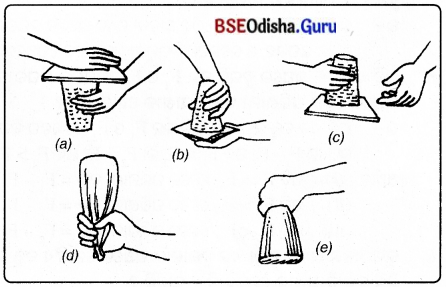
![]()
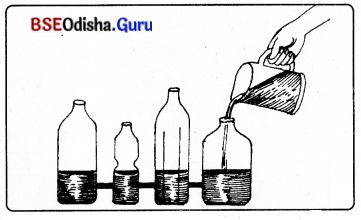
![]()
![]()

